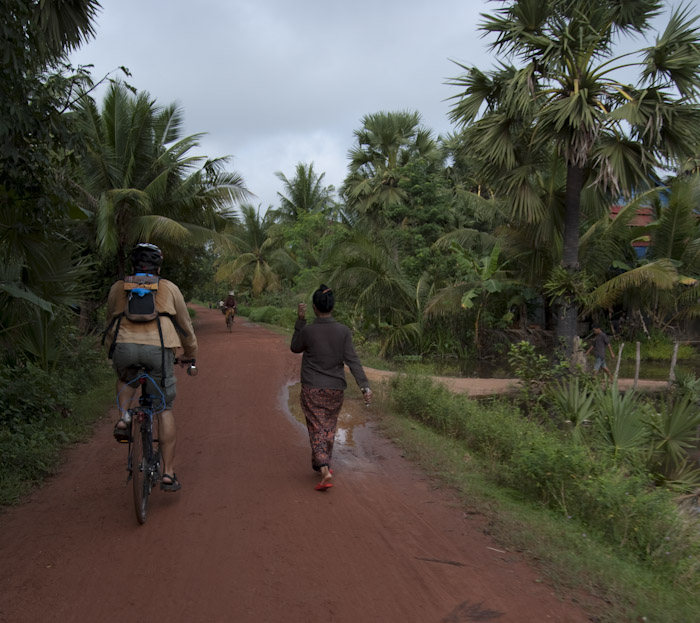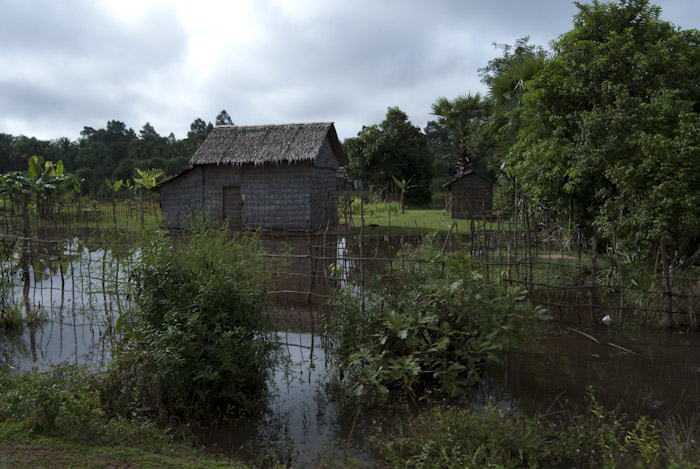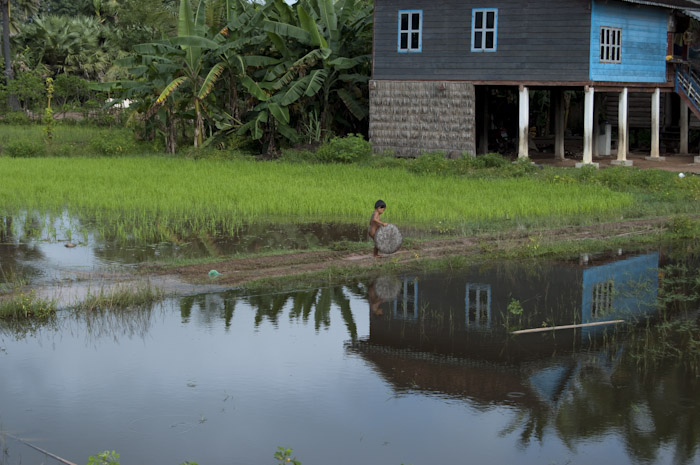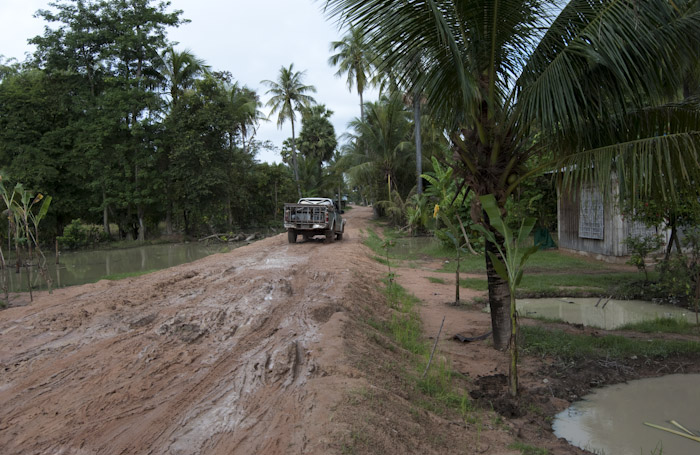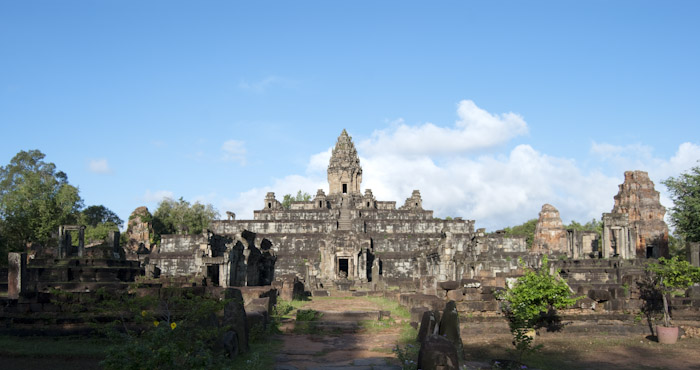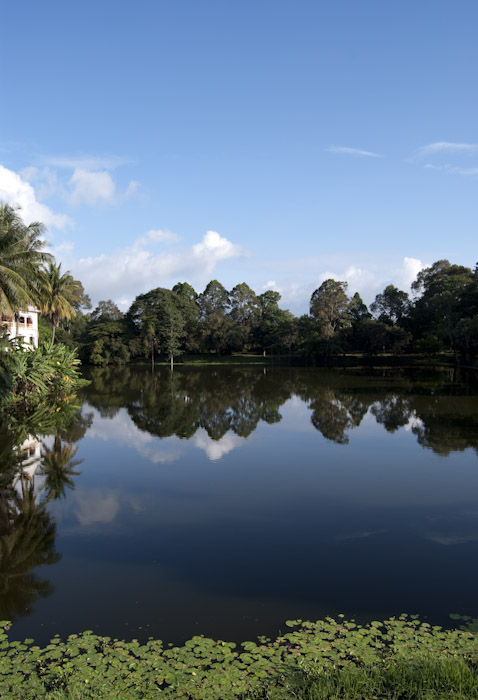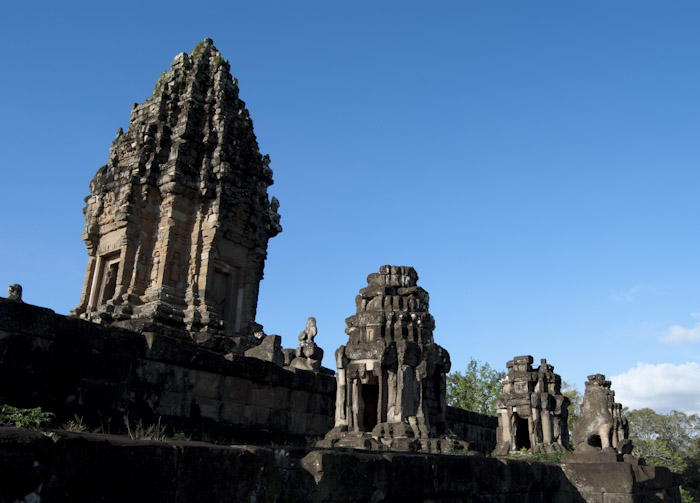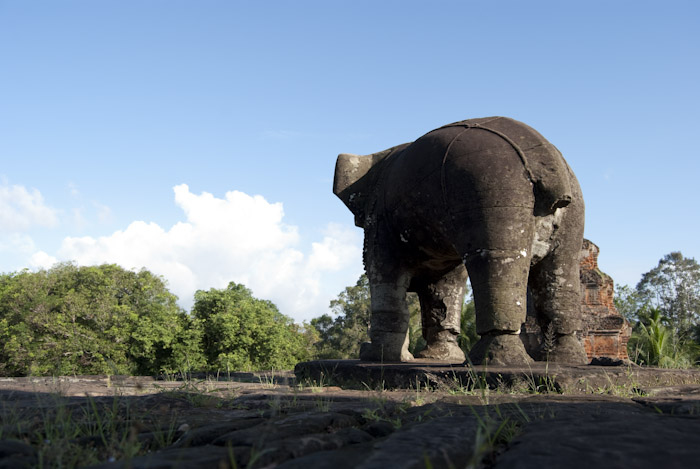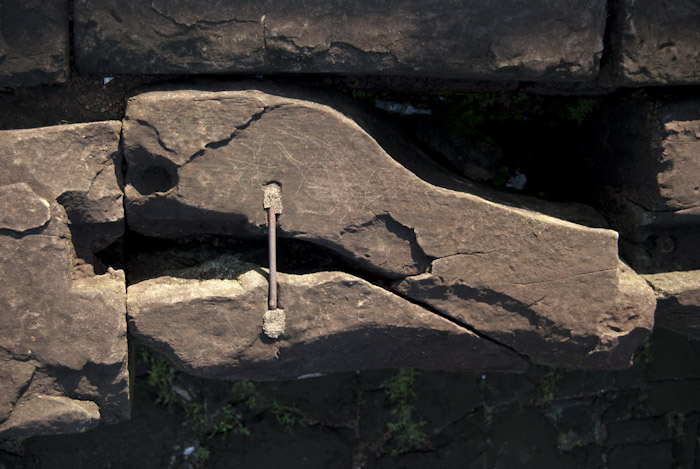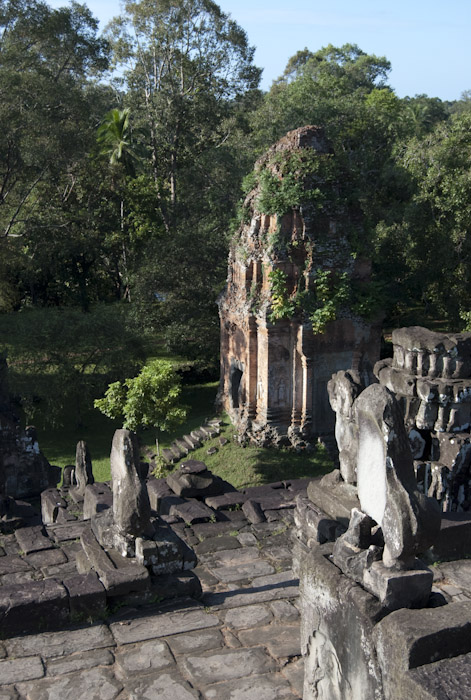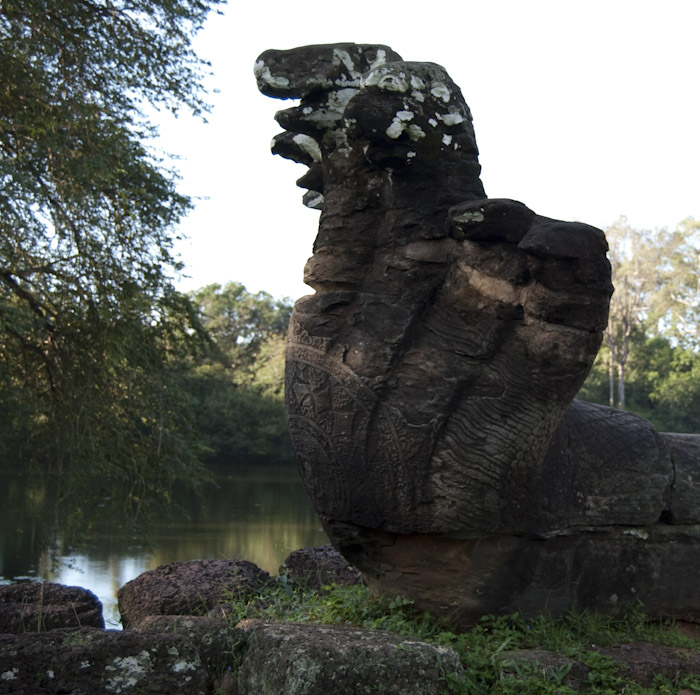Thailand Bicycle Trip 2009: Part Two
Contents
Angkor: Near-Sites Tour by Tuk-Tuk
We get up around five, and find breakfast a ways down the street and around the corner: rice with meat and eggs. The establishment is centered around the TV, and as we eat the roadside just outside accumulates a contingent of non-customers also sitting and watching. After breakfast we stop by the pharmacy we found last night, picking up a pancho for me (Micah came supplied), and bug repellant. Prepared, we start out walking North along the turn-off to Angkor. We assume — with strong evidence from being accosted often the evening before — that it will be easy to find a tuk-tuk for the day, and our plan is to walk until a driver with reasonably good English finds us. We have hardly rounded the (pot-hole and puddle blasted) corner turning north before this works, and we hire H for the day. For $15 (paid at end), he will take us on the short one-day circuit.
The ride in is pleasantly padded after a few days on bikes; it is also remarkable to watch the ramshackle congestion of Siem Reap give way to clear roadsides, light poles, and fancy hotels.
We make a preliminary stop for tickets; we opt for the three-day consecutive pass, at $40 each. (This means we get it punched once, when we buy it, and can tour indiscriminately for the coming three days.) The passes include a photo they take of us as we buy it, though they are printed on regular paper.
Angkor Wat
Our first stop is Angkor Wat. H parks in the tuk-tuk lot, where he will wait for us, and we are immediately beset by local children selling tourist wares: they will remain a constant fixture of our visit. (Ten bracelets, one dollar, Mister; ten postcards, one dollar; I think you need a guidebook, Mister; when you come back, I think you come to my shop, okay?)
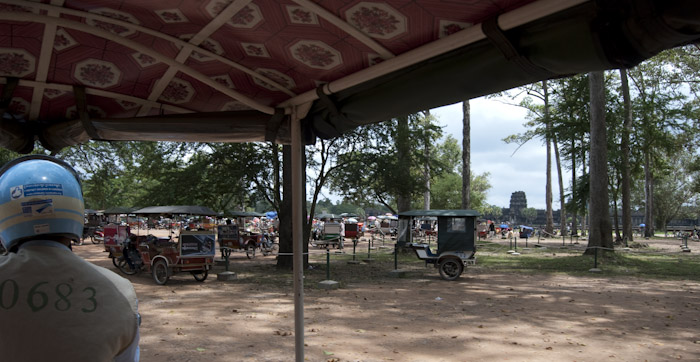
The lot filled with waiting drivers is a good example of infrastructure far beyond the needs of the tourists present during our visit.
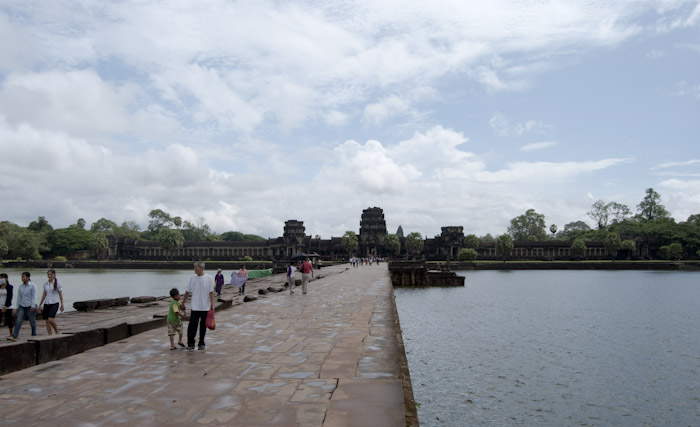
The front facade of Angkor Wat waits past its grand moat. As we depart (around eleven), there are a few more tourists than when we arrive; it has also rained briefly in the interim.
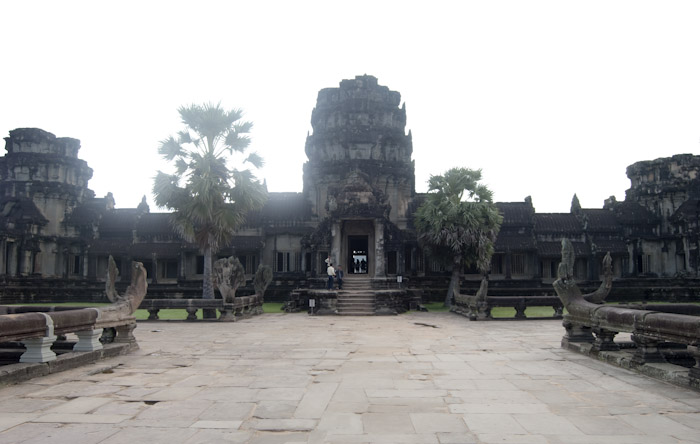
From the moment we walk up to Angkor Wat, we are plagued by dark stone temples against bright, backlighting skies, here accentuated by my lens which starts the day smudged.
We acquire a tour guide (he is waiting by the entrance, and although we had planned to do a little self-touring first he is informative), and head into the temple. He tells us about its history: originally Hindu, then Buddhist, and somewhat pock-marked from bullets during the Khmer Rouge. This explains why the bas-relief covering the walls (as well as some of the statues) are Hindu-themed, but statues of Buddhas also line the hallways. (Most of the statues' heads have been looted.)
One of the things which impresses us most, and continues to do so at the other sites, is the extent to which every surface is decorated: everything is ornately and densely carved, whether in designs or figures or, as we see towards the back, in complete battle scenes. Another is the enormity of the construction as a whole.
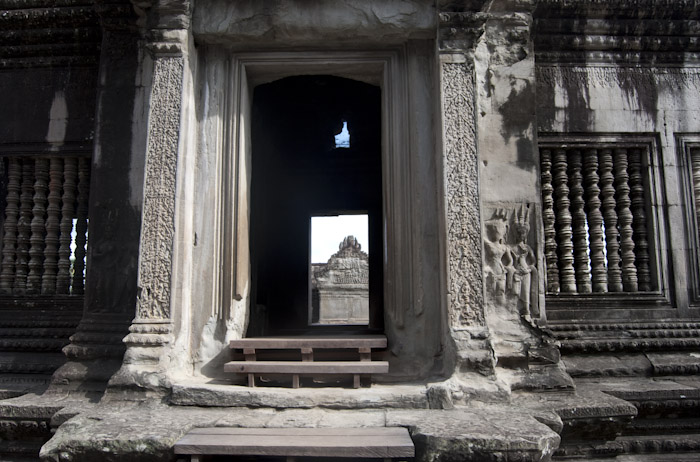
Although some steps have wooden platforms over them, for the most part visitors walk directly on the artifacts.
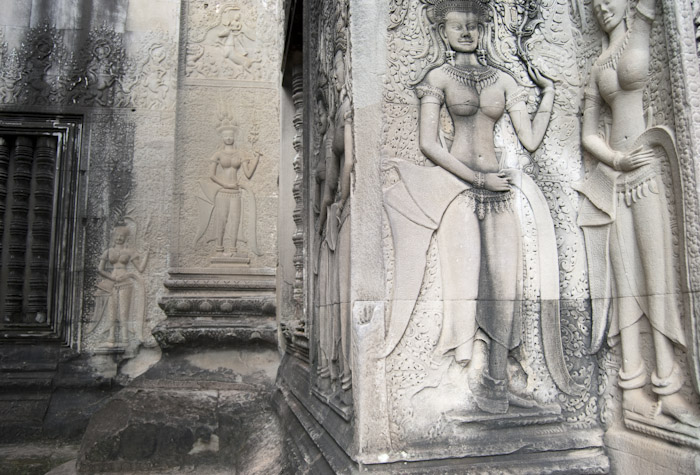
Part of our guide's tour took us along an exterior ledge, the better to see the carvings.
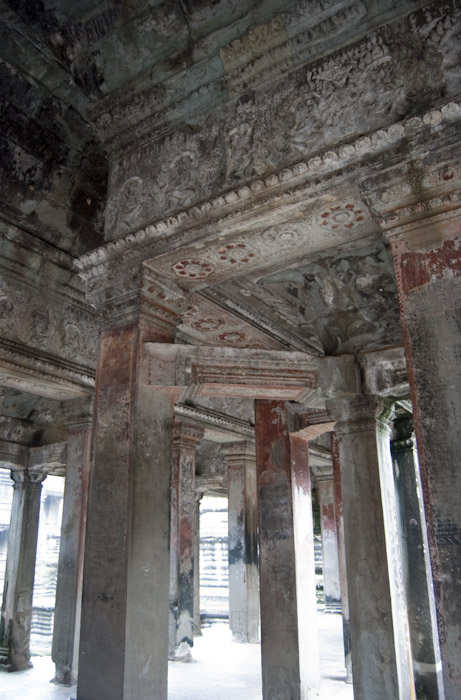
It doesn't stop being ornate.
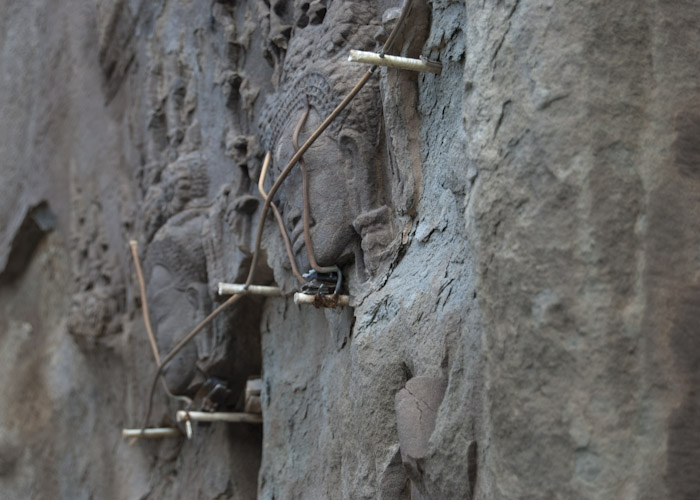
There are various stages and means of protection and restoration, including some restoration which involves removing corrosive elements from previous restorative techniques.
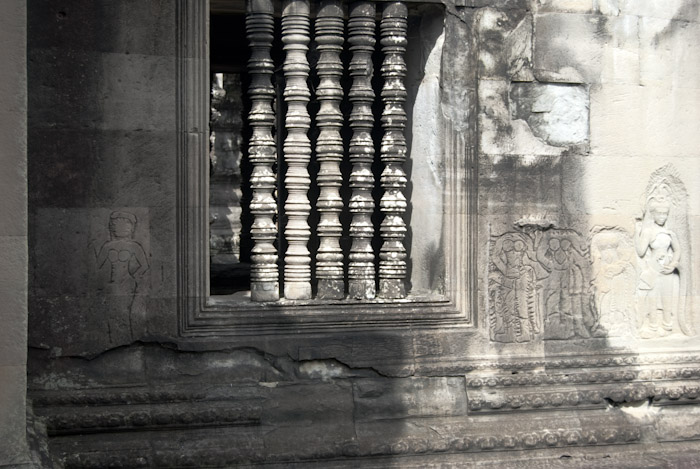
The king died before the temple was entirely complete, at which point work stopped, here (we surmise) leaving outlined but unfinished bas relief.
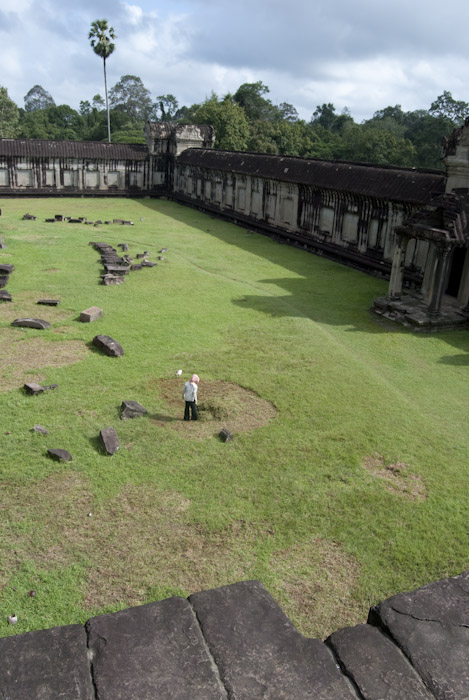
Locals cut (to collect) the grass, here seen nearing the back entrance.
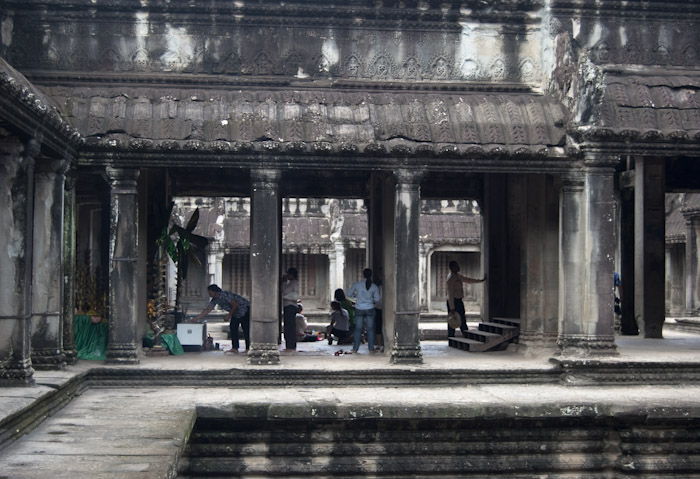
Most (if not all) of the temples feature active shrines.
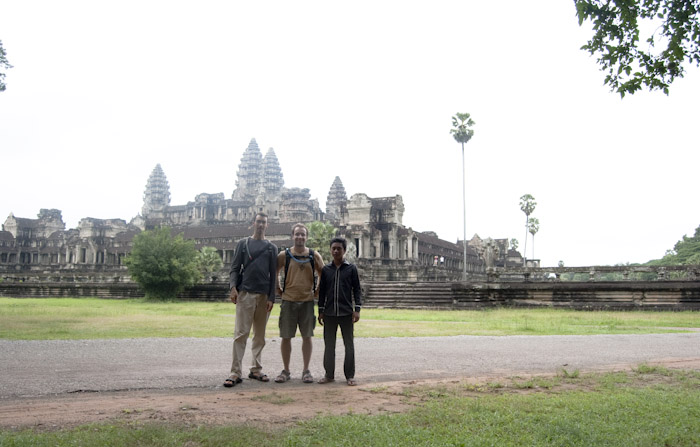
We were there (with our guide for the morning).
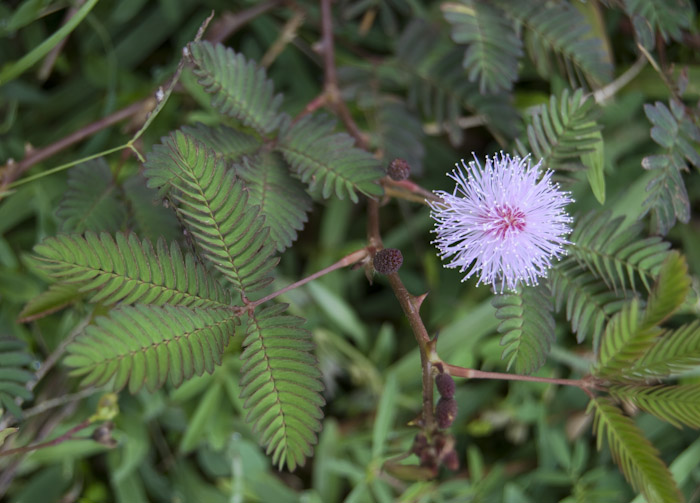
Our guide points out a patch of Mimosa pudica, which curls up its leaves when touched.
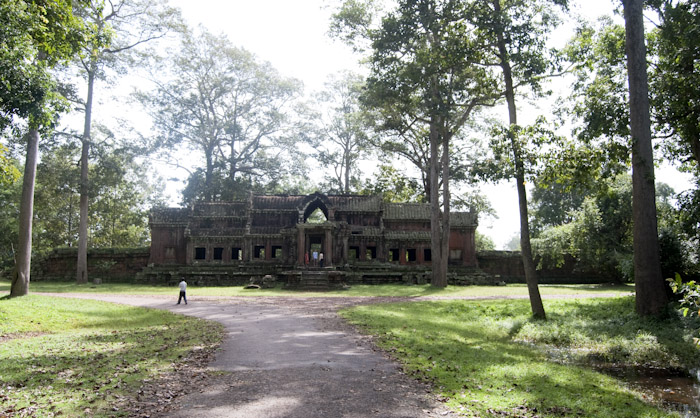
Behind Angkor Wat is its west gate.
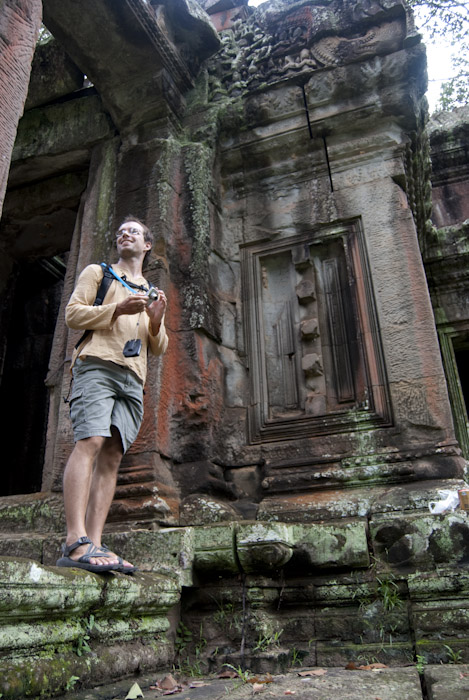
(Also the gate.)
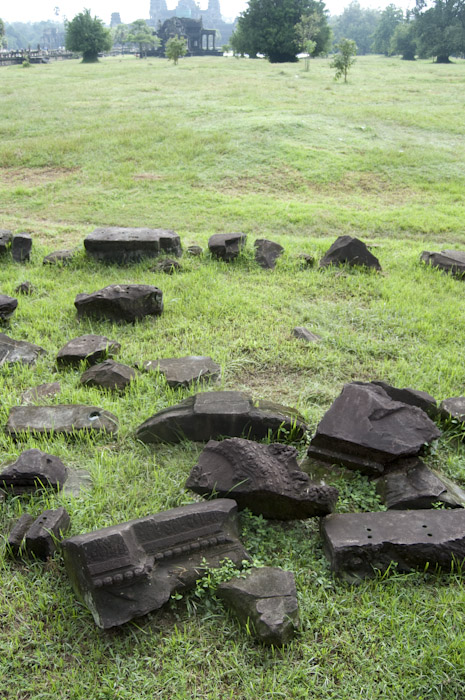
There are often areas strewn with parts of nearby structures; here, next to the inside of the main corridor around Angkor Wat.
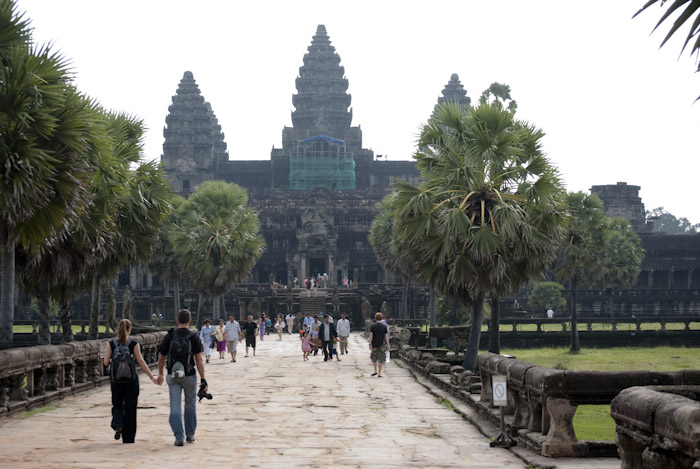
The main causeway through Angkor Wat leads to the back towers (here pictured) from the front entrance.
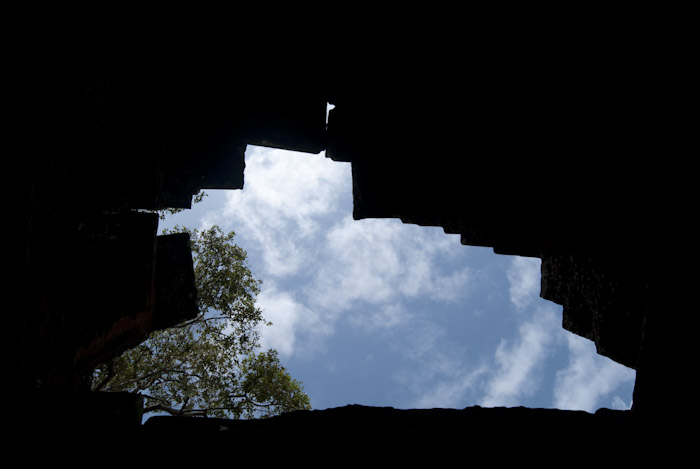
We lunch in touristville, where H drops us off. (Returning to the parking lot, we jump in the tuk-tuk to escape the vendors before deciding we should eat lunch before going; H pulls around and drops us at one of the line of near-identical restaurants along the edge of the lot.)
My reactive stubbornness aside, Micah takes up one of the many offers to sell us a guide book. It turns out to serve us well, having all of maps, good advice on which sites to see, and interesting technical details. At $10, it is below half of list price, so we oscillate between feeling it is money well spent and, given comparative shopping options (and its being several years old), feeling we've gotten a raw deal.
Angkor Thom
Next, we head into Angkor Thom, a large walled area — once a city — containing a number of sites.
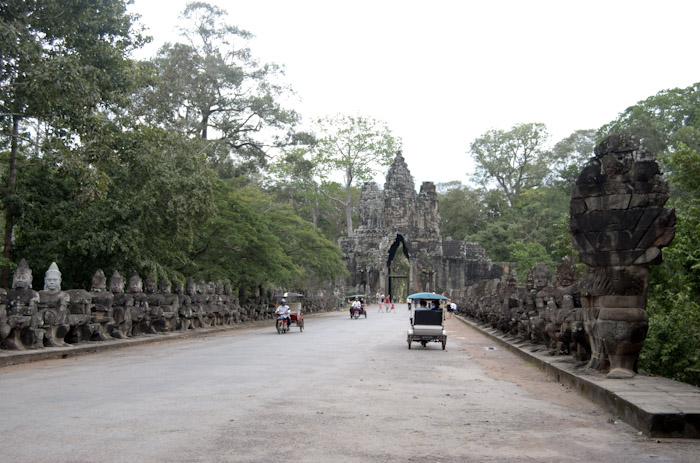
Our first stop is the Bayon, which will become an enduring favorite of ours for its dense, maze-like interior and almost-natural mountainous aspect.
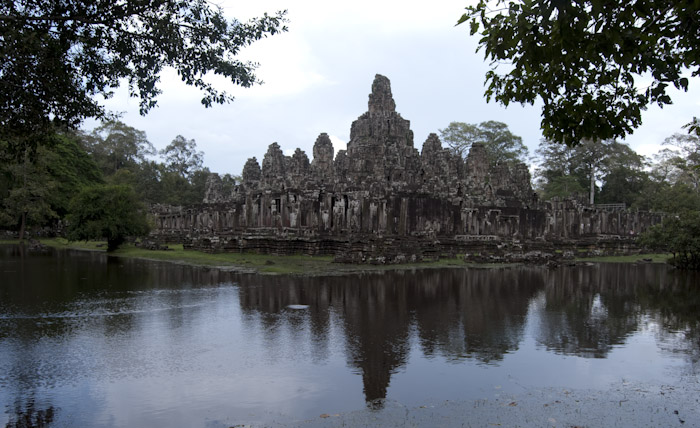
Like all good edifices, the Bayon has a moat and reflecting pool.
I am admiring the strewn rubble beneath the trees opposite as we round the approaching bend, and am staggered when I glance to the other side and find our second massive temple having appeared. H parks and we head inside.
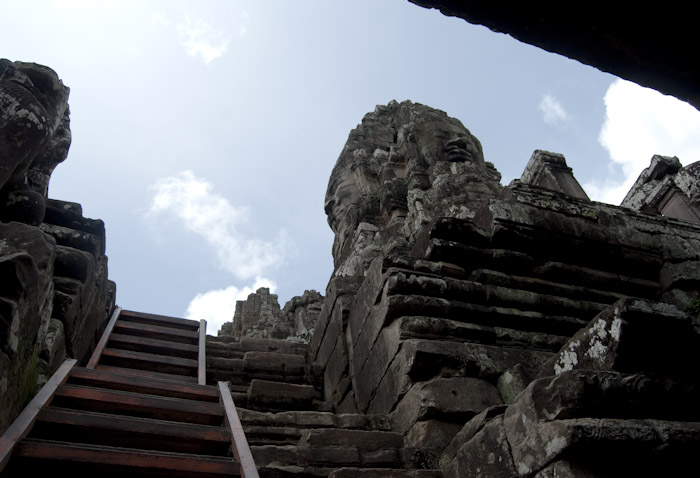
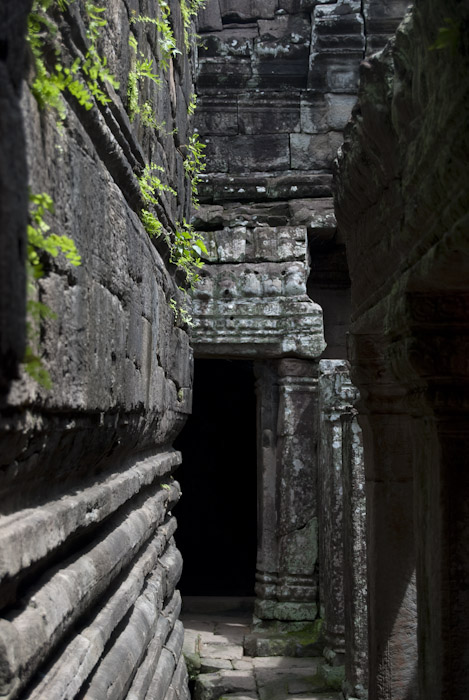
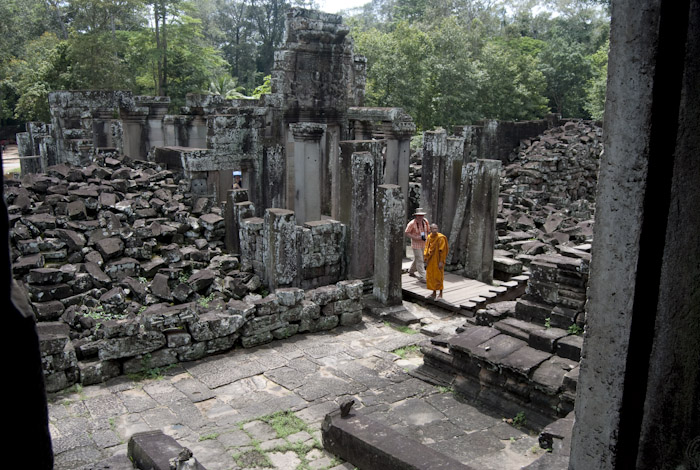
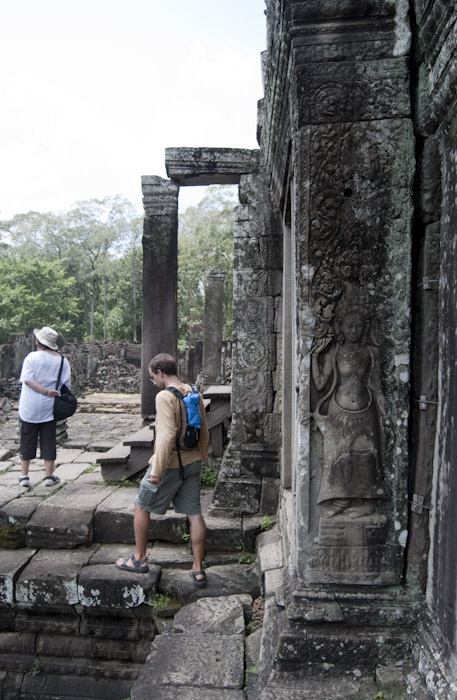
I continue to have mixed feelings about the lack of protection for the ruins: It's great to be able to explore undirected and get so close to the carvings, but I can practically feel irreplaceable archeological data disintegrating every time I stop or brush a wall.
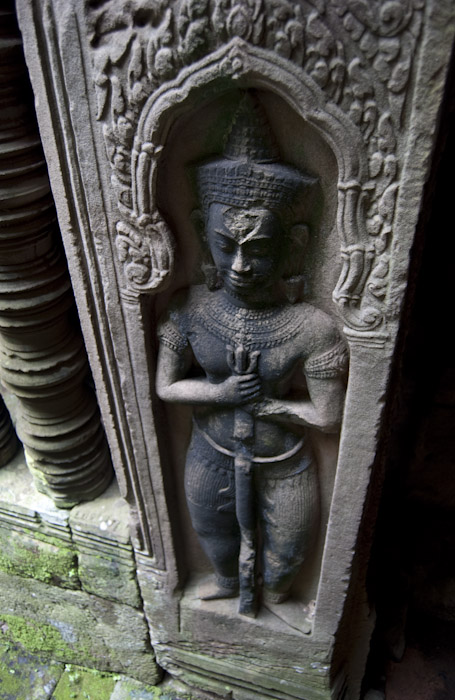
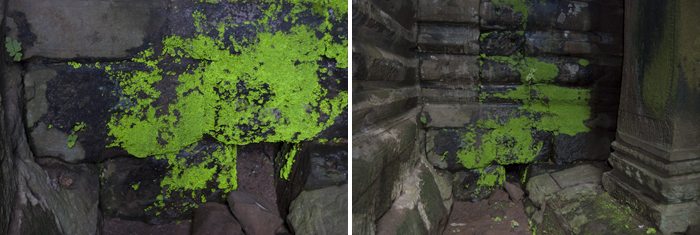
We discover a plant which is directionally reflective, like road signs: from near the angle of the incident light, it glows astonishingly; from an oblique angle, it looks like standard moss. (Another tourist who passes through while we are admiring it seems marginally impressed.)
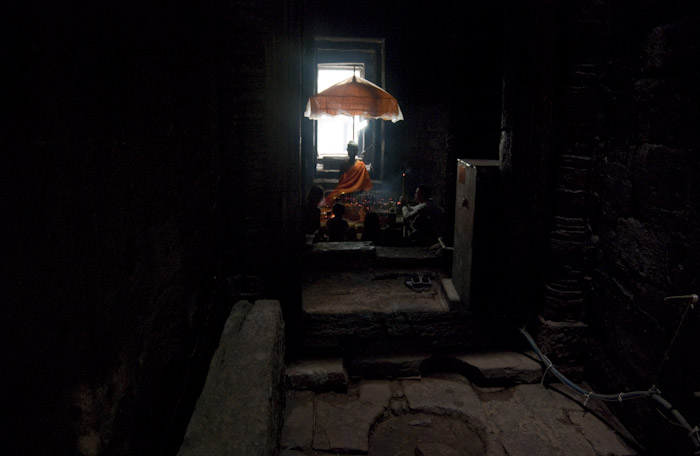
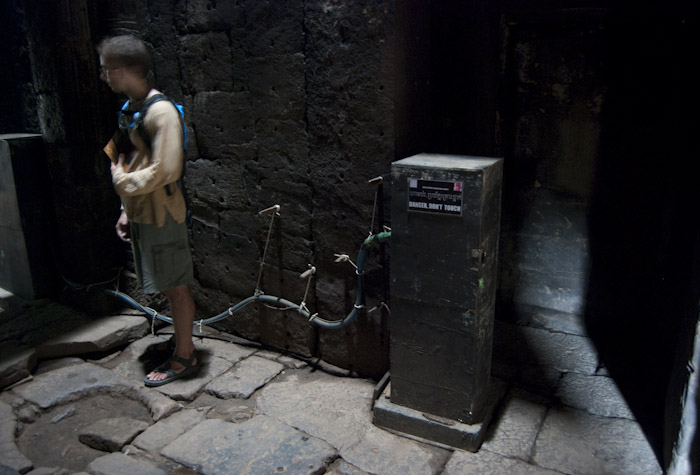
Some fixtures make it especially not hard to think of Indiana Jones.
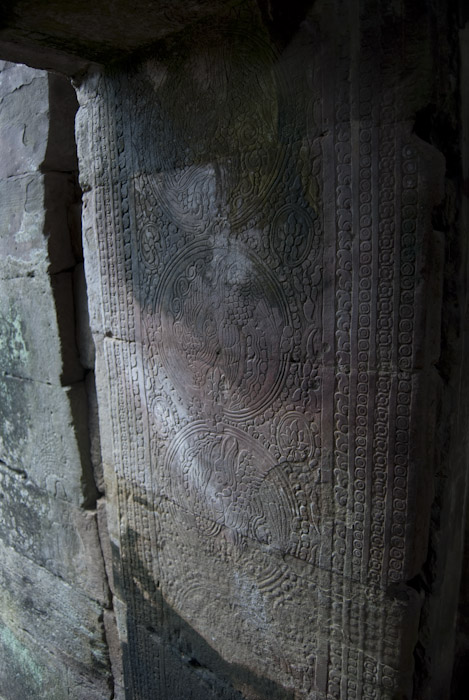
Although decorated surfaces are standard, the designs continue to vary.
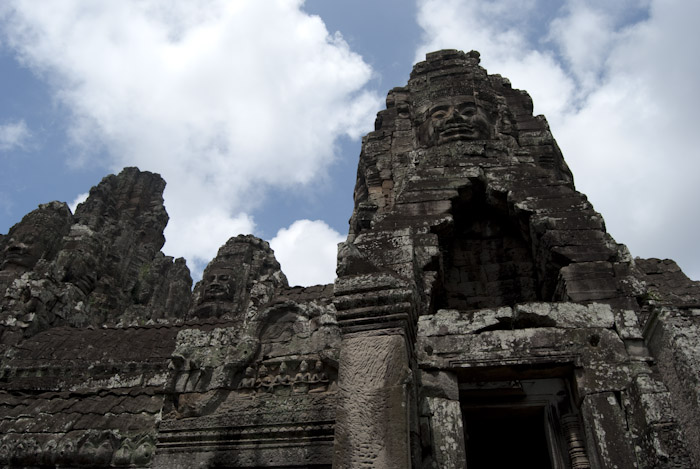
All of the towers have giant faces on all sides.
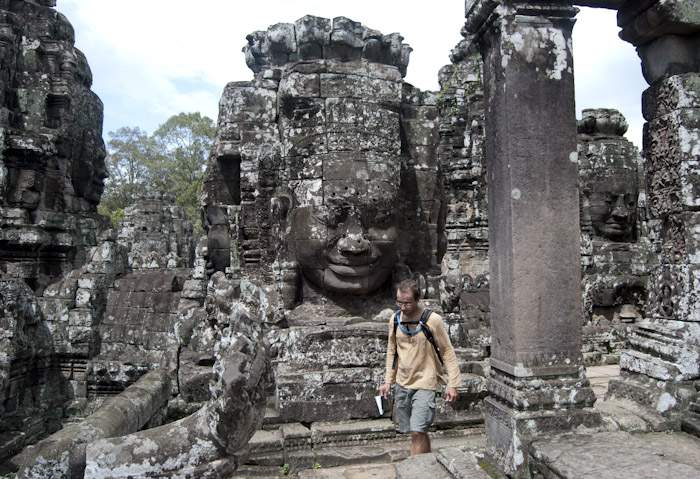
Leaving the Bayon and heading north, we pass over the causeway for the Baphuon; the main section is closed, so we head on to Phimeanakas.
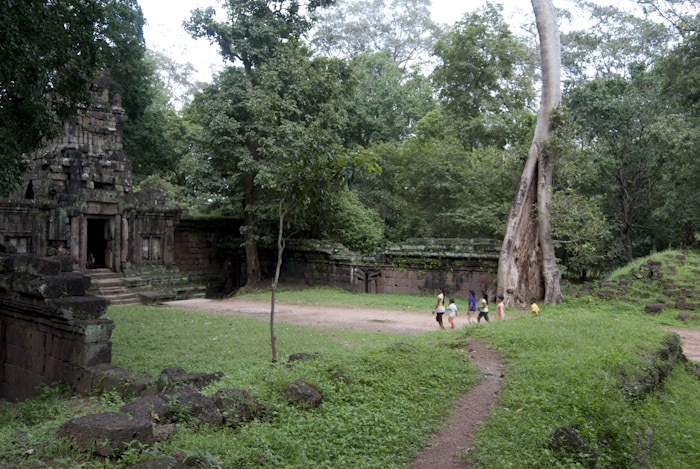
Phimeanakas has an enclosing gated wall.
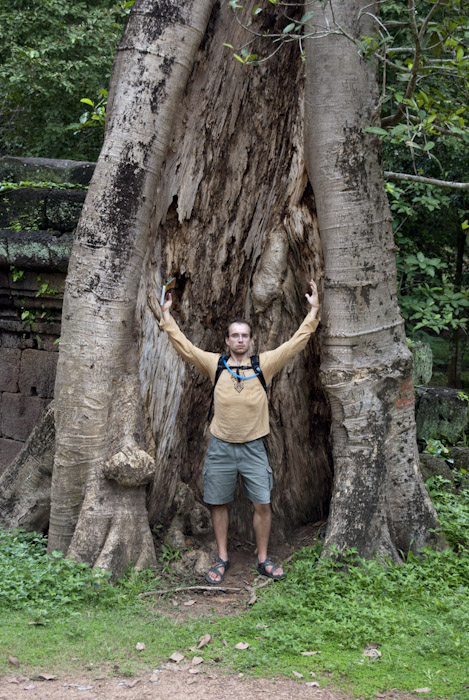
We stop along the way for silly pictures.
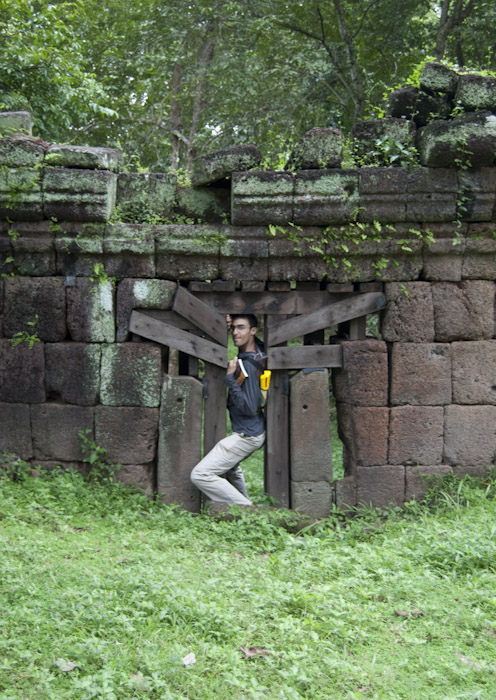
(We swap camera and guide book for a moment.)
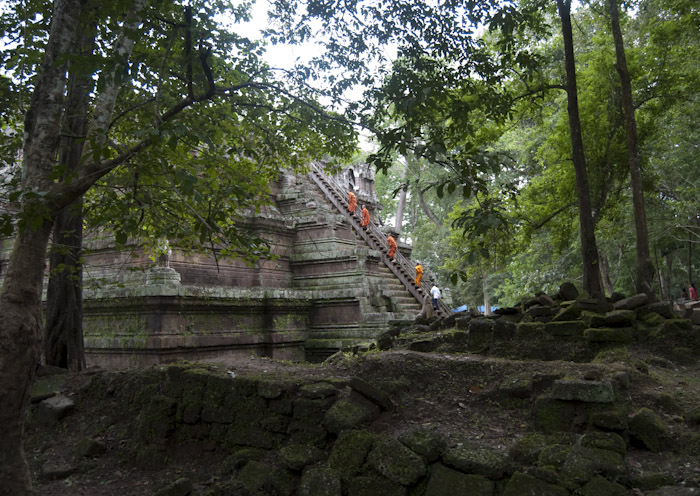
Phimeanakas is relatively small and very steep.
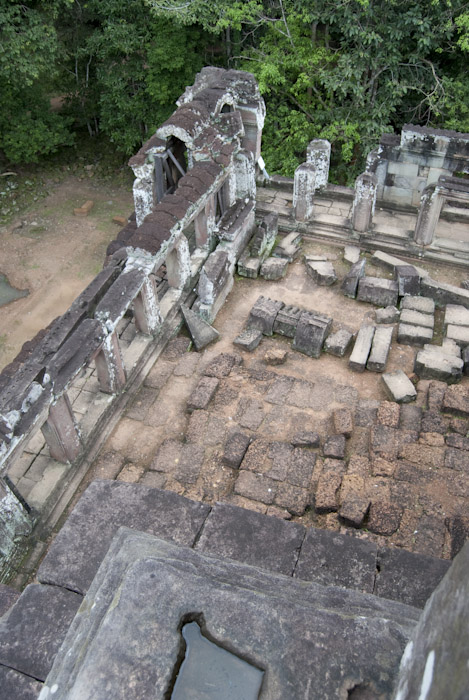
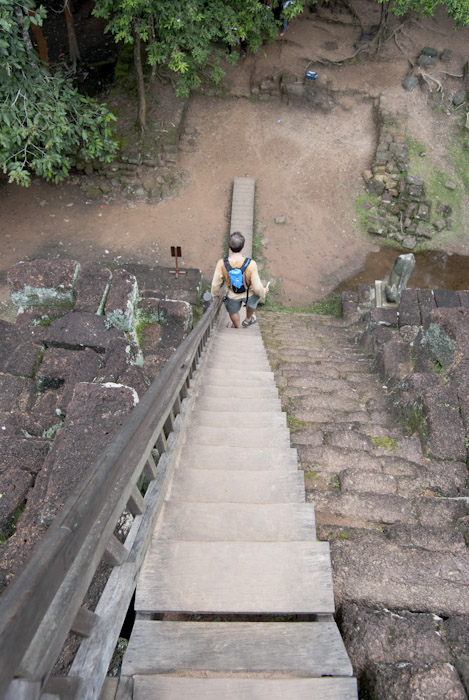
Micah points out how the top step is conveniently slanted, in case you need help to get going.
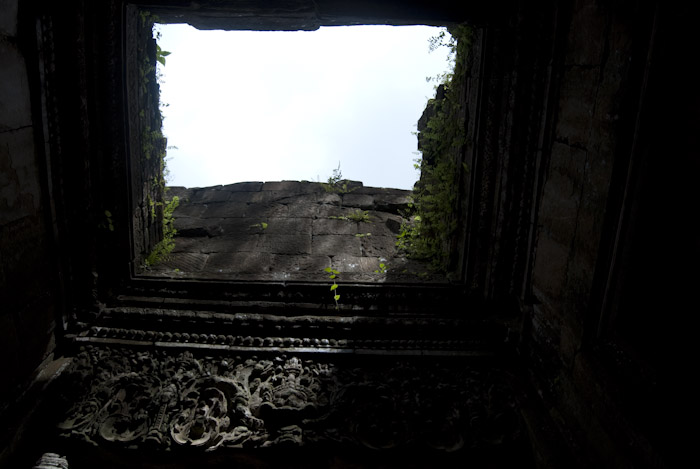
There are enticing holes in ceilings and walls everywhere — here, in the roof of Phimeanakas' east gatehouse. (panoramio)
We head out Phimeanakas' east gate onto the Elephant Terrace. The approach and the view combine well for granduer: from under the gatehouse, to the broad steps up to the terrace, and then opening onto the raised terrace which stretches the breadth of a clearing, and towers on the clearing's far side. Micah catches the feeling, projecting: Why, man, he doth bestride the narrow world like a Colossues, and we petty men.... We walk along the terrace, determine it does indeed have elephants on its facade, briefly admire the nested pair of walls on the Leper King's Terrace, and then as it begins to rain take refuge back in the tuk-tuk.
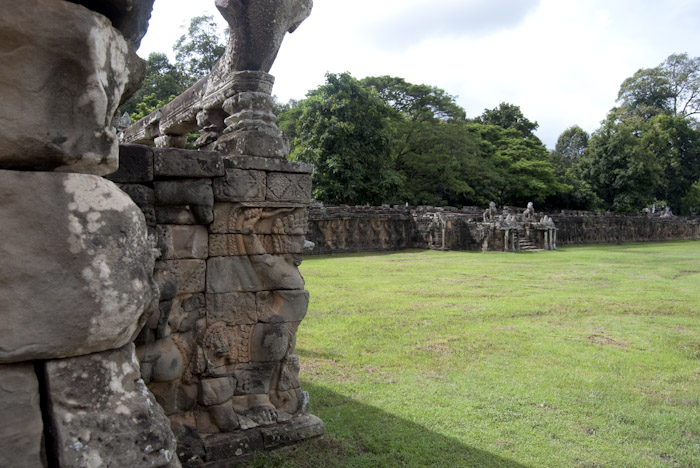
The Elephant Terrace has a broad walkway (on top, not visible here) and elephants which decorate the corners and ends of the stairways (but not this closest pictured section).
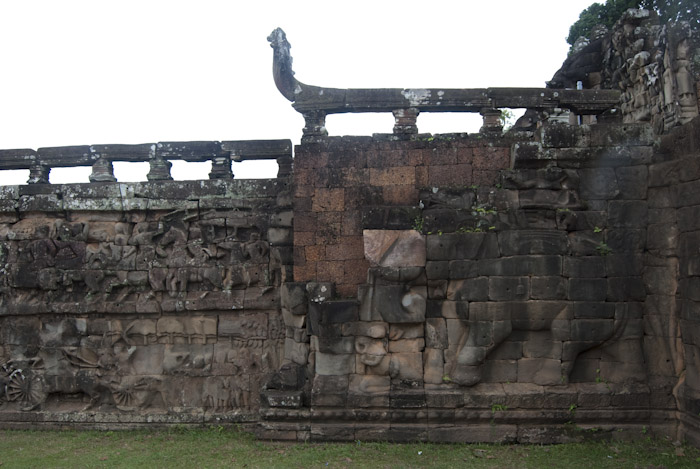
It takes a little looking before we see the eponymous bas-reliefs.
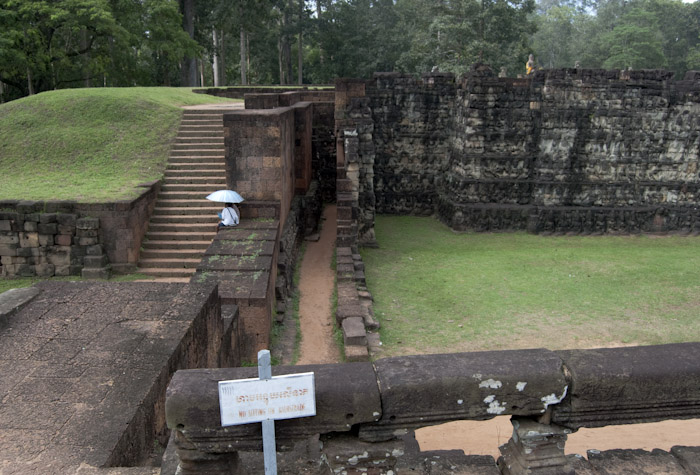
An excavated gap runs between the two sets of walls on the Leper King's Terrace.
Thommanon, Chau Say Tevoda, Spean Thma
Onward, out the east gate of Angkor Thom, we stop at two small sites, interesting for their contrastive restoration. (After only a few sites, we have grown accustomed to the first impression of size and age and decoration; but the individual structures continue to present different variations.) Thommanon sports concrete ceilings — entirely incongruous, looking like paneling. Across the way, Chau Say Tevoda has in-place replicas of many portions of facade; they give it a patch-work appearance as we approach, but work better once we're walking through the temple.
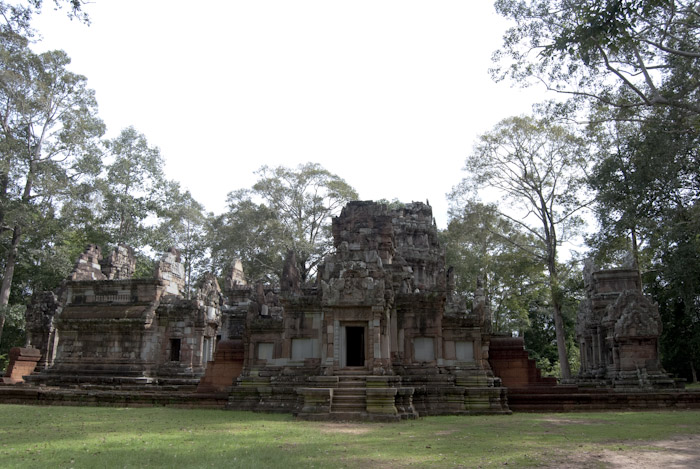
Chao Say Tevoda: On approach, the different colors of the replica and original stonework do not mesh.
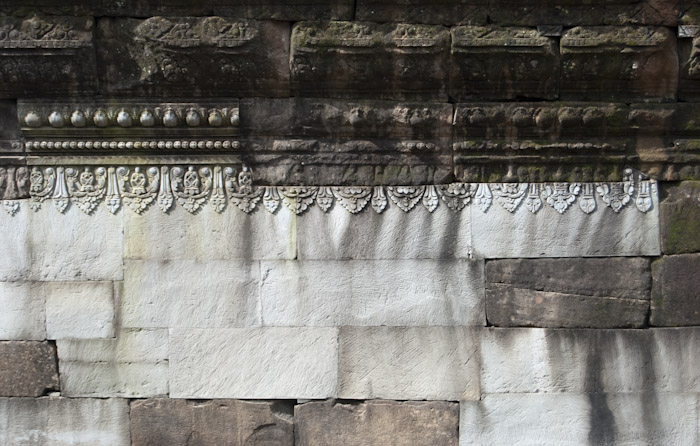
Once closer, we find the restored sections more informative.
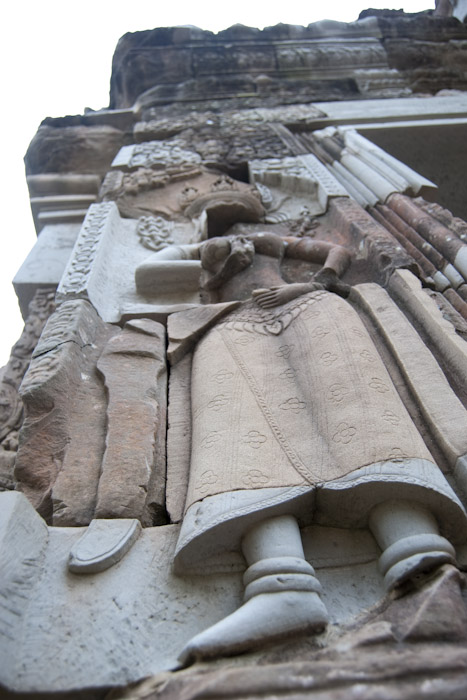
Some restoration remains baffling; notably, the variation in color among restored pieces.
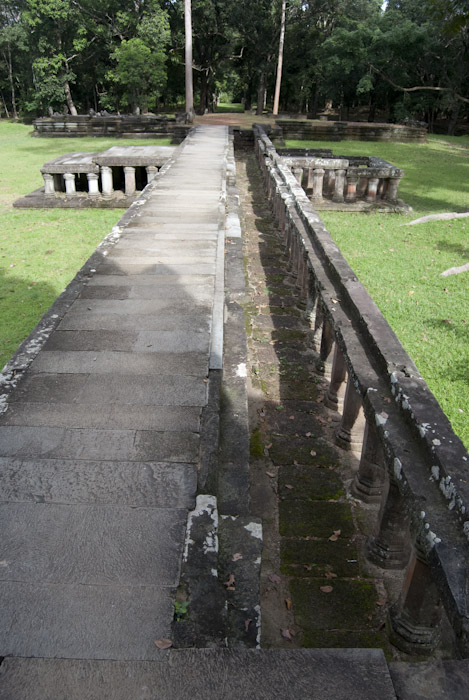
The walkway shows another variety of restoration: Our guess is that the best-preserved parts have been consolidated to one side.
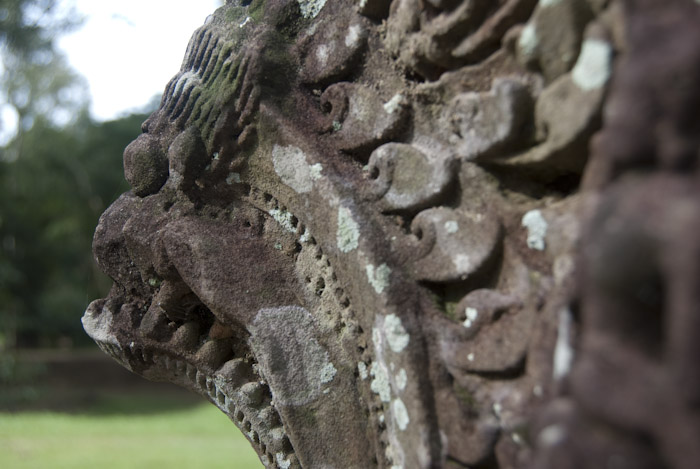
Naga are a common decoration for ends — here, on a loose balustrade section.
We are struck (on various occasions) how the smaller sites are marginalized by their surroundings; temples which anywhere else would be amazing historical sites are, here, hardly worth a stop.
Along the road we stop at Spean Thma, arches from a bridge now attractively arboreal. We stop for pictures.
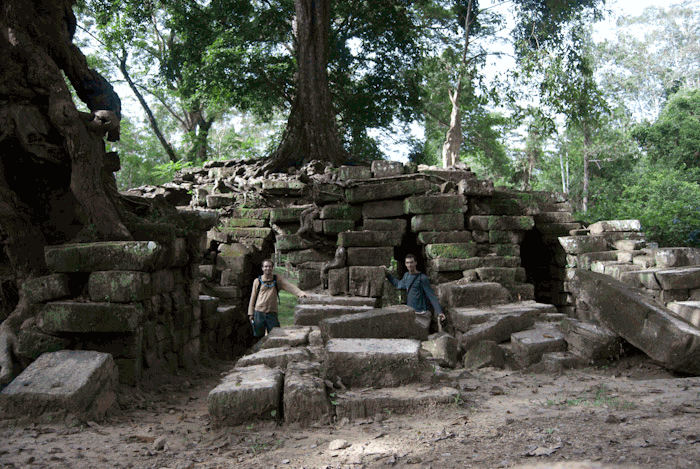
Ta Keo
Although we are well used to steep temple steps, Ta Keo impresses us with its extreme and several-tiered stairs. Its other defining features is its lack of adornment, work on which was never completed (nor hardly begun).
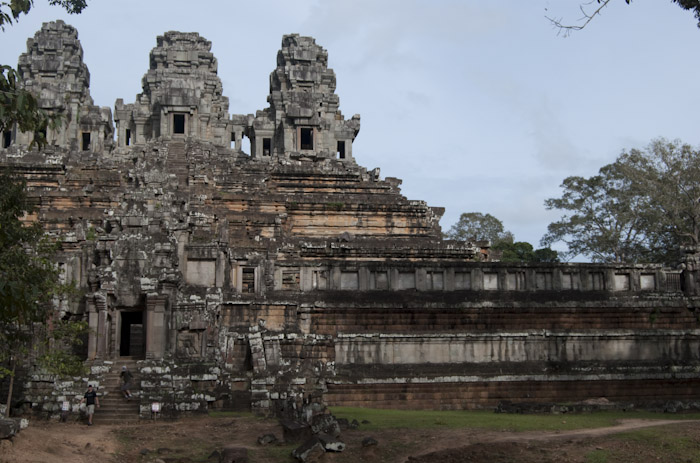
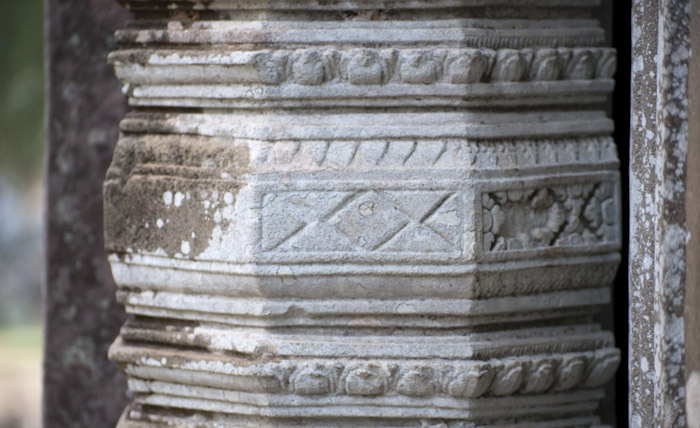
A column so illustrative of stages of carving seems too textbook to be true.
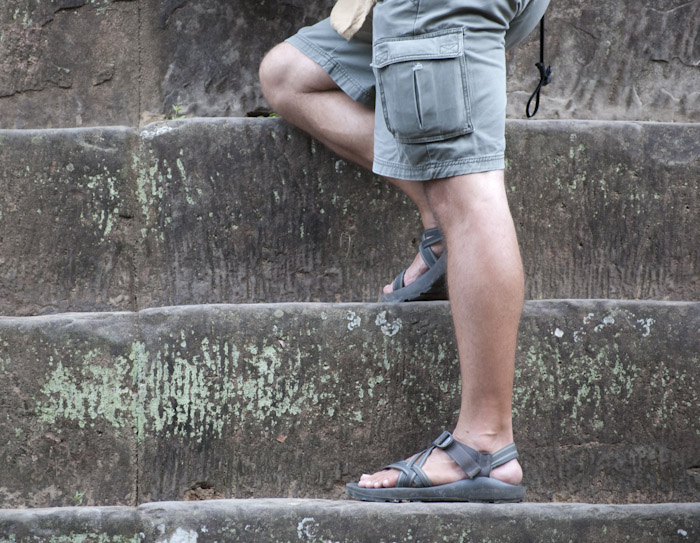
The steps are not much wider than our feet.
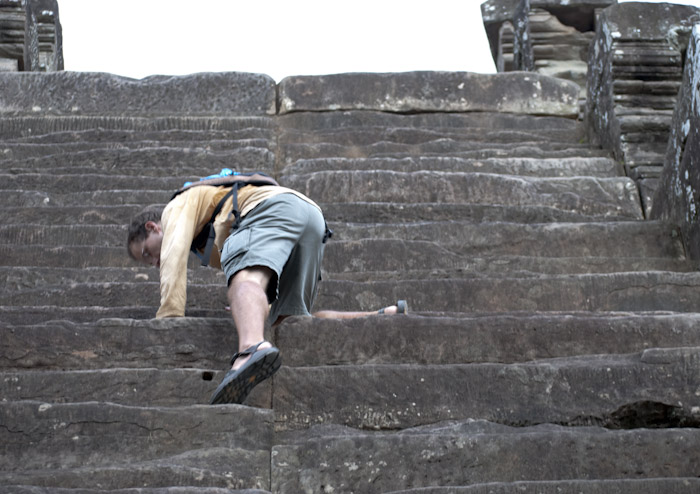
Halfway up, one of the steps is double height.
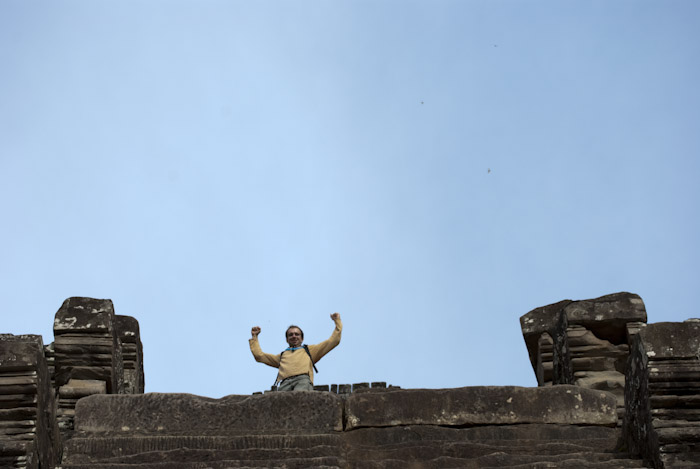
The guide book informs us that the monk given the temple deemed himself unworthy to use the higher level; we guess he may have had ulterior motives.
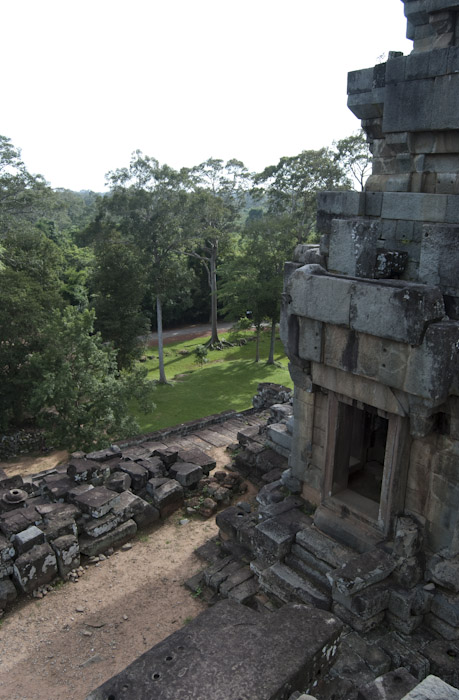
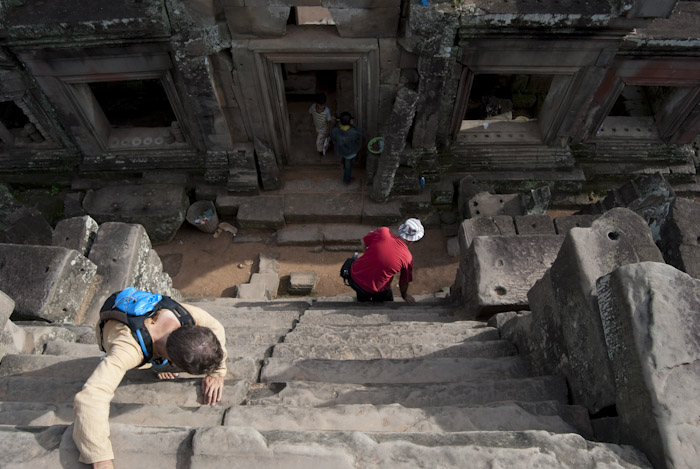
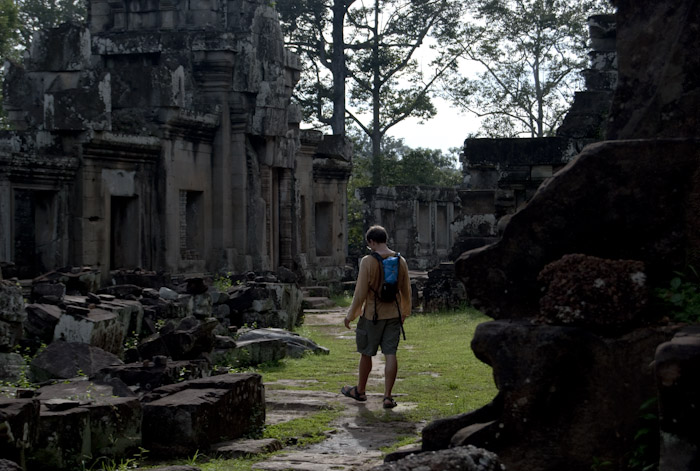
Ta Prohm
We rendez-vouz with H, who takes us to our next stop, Ta Prohm. (In the parking area, there is an ice cream truck; after most of the day climbing around ruins in the tropical sun, we are both ready to pay a dollar for an ice cream bar.)
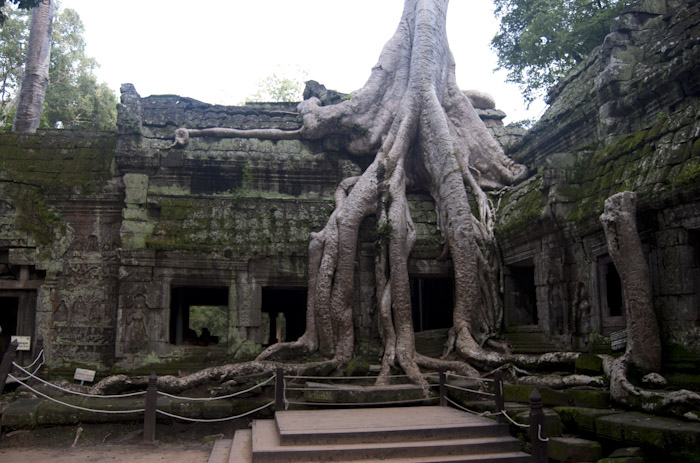
Ta Prohm is preserved, but not restored. Walking into it, we feel even more than usual like we are discovering a hidden ruin; Micah ruminates, and I agree, that it would make a good first stop for an Angkor tour. The trees are equally massive to the temple they are growing in and around, and are a pleasing visual counterpoint — long organic lines against stone blocks. (If we were more culturally aware, we might recognize parts from Tomb Raider.)
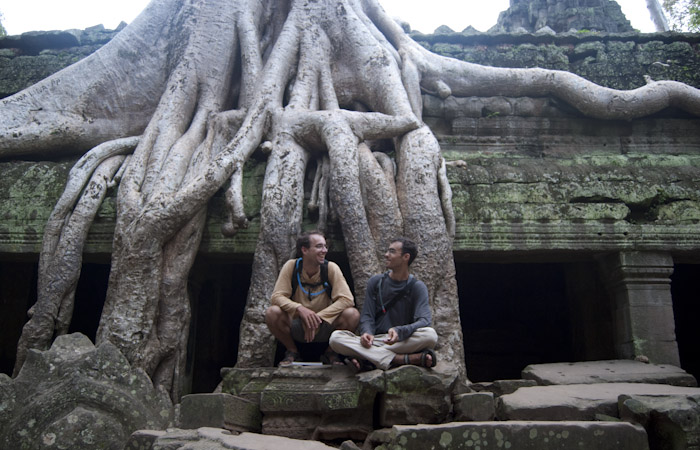
We avoid taking our picture on one of the provided take-your-picture-here platforms.
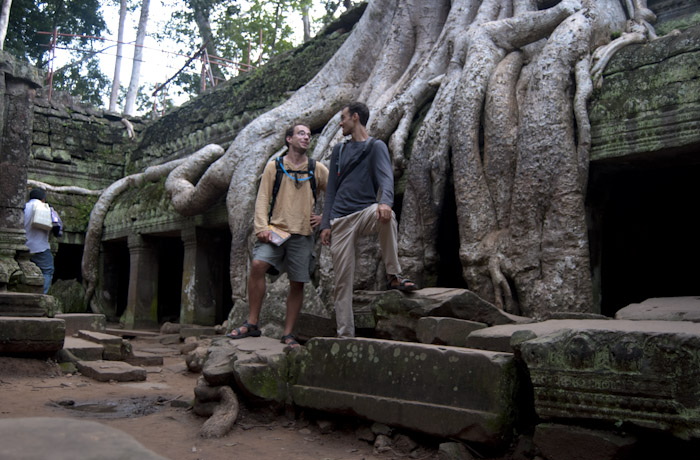
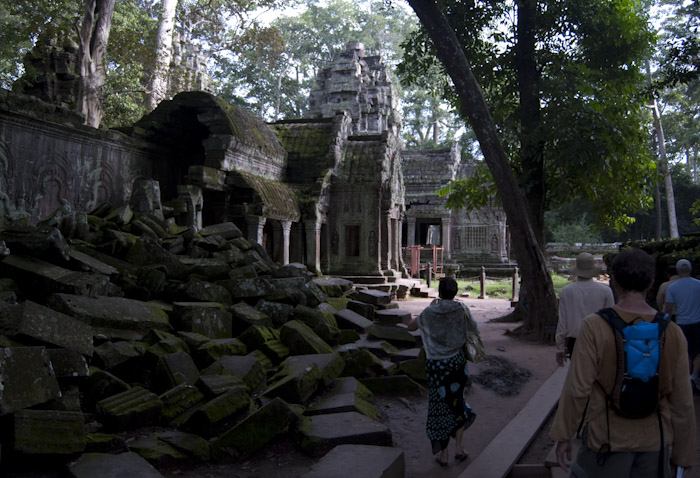
Seeing the cascaded rubble impresses us with how much rock went into the buildings.
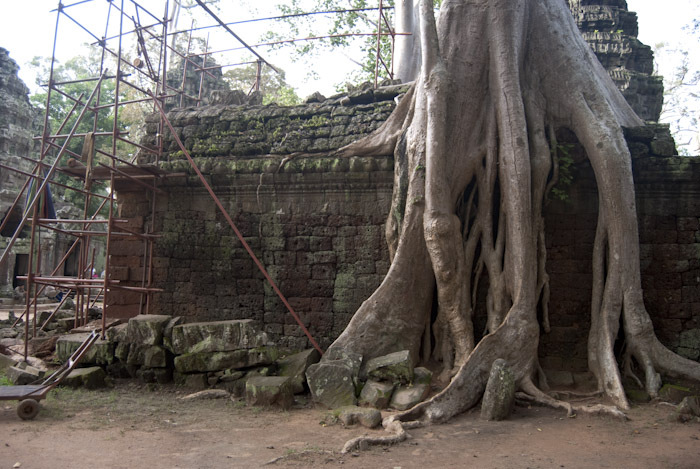
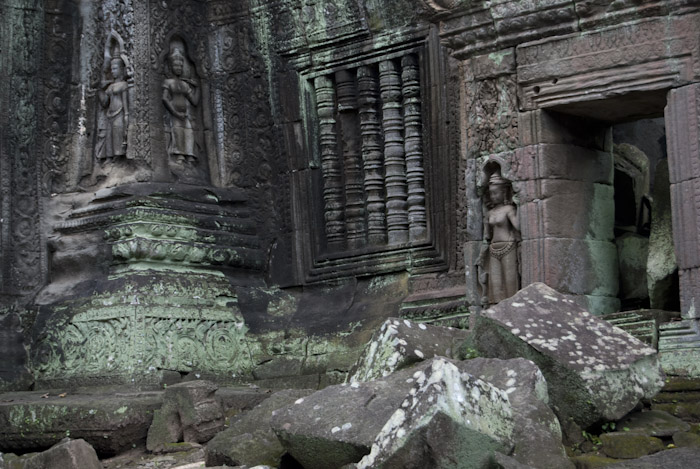
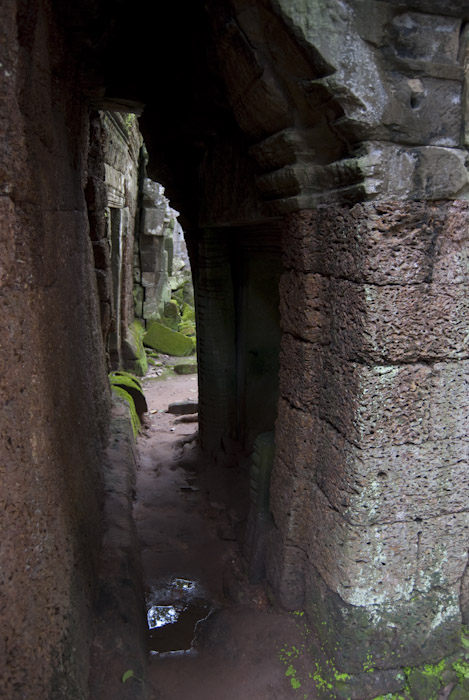
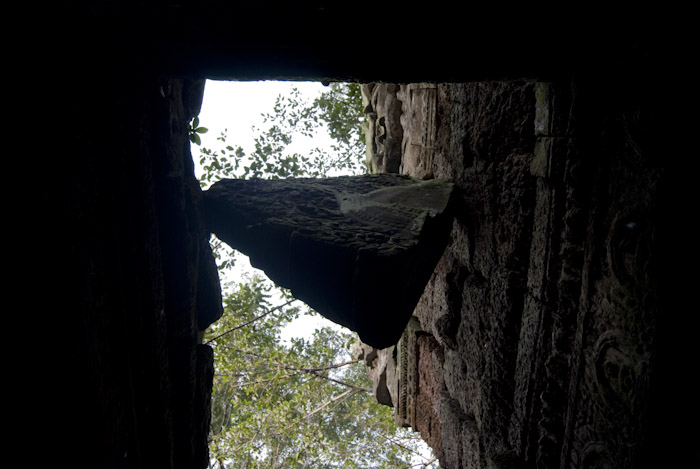
Micah points this one out: waiting to finish falling.
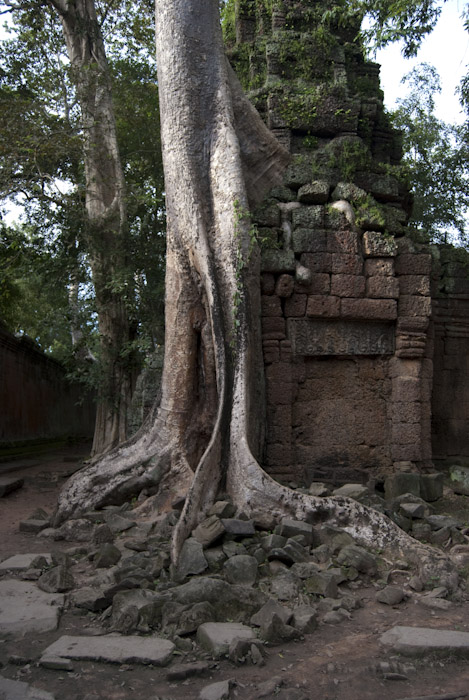
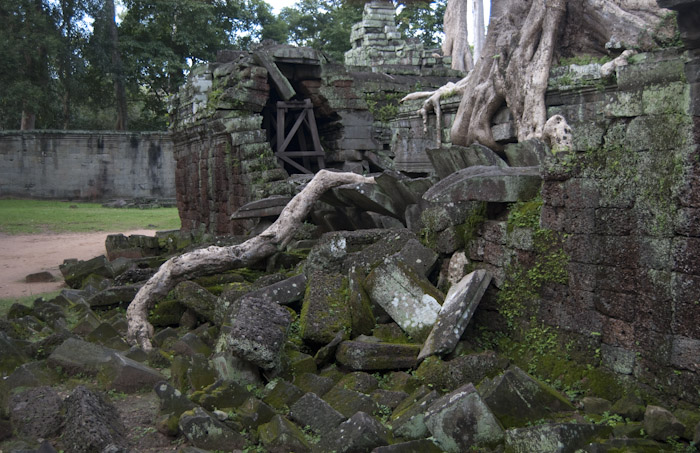
Banteay Kdei
We make one last stop for the day at Banteay Kdei, with dusk approaching. A few of the girls selling the usual tourist items — bracelets, postcards, etc — attach themselves to us with unusual vigour, whether just because it's the off season, or just the end of the day.
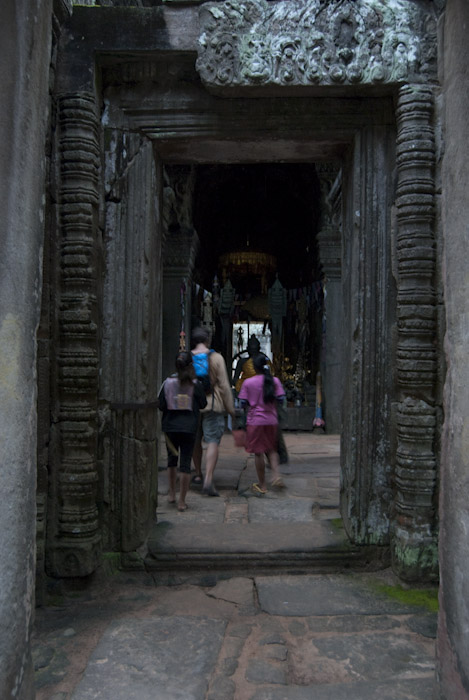
They follow us as far as the temple center, where there is the usual active shrine. As well as excellent persistance, they have remarkable conversational skills in English, can answer a little French, and speak Thai (presumably in addition to fluent Khmer).
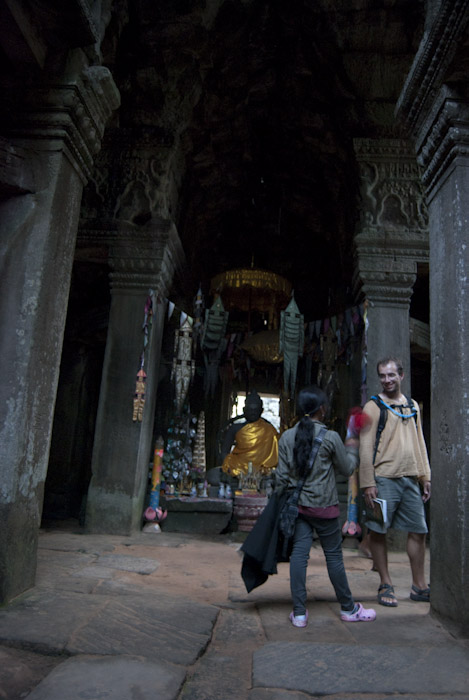
They brand Micah Mr. From Thailand, having found that out about him. (I earn only something to the effect of Mr. Tall or Mr. Thin.)
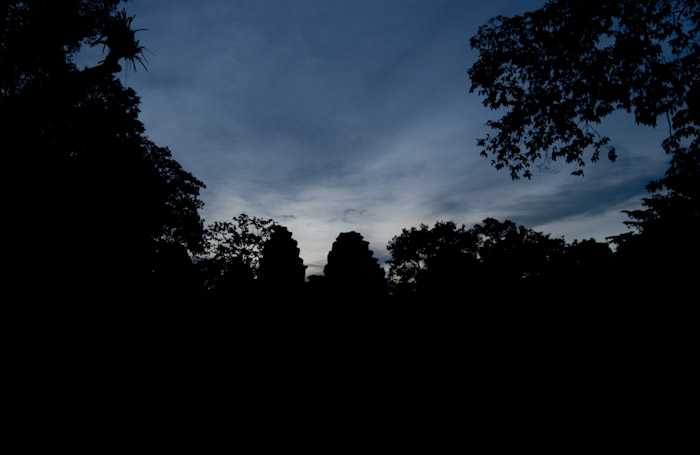
We wander through the rest of the temple as the sun goes down.
Evening
H drives us back into town; we admire the lights (including what looks like a ferris wheel) off to our left. H offers to take us to a buffet dinner, featuring (we are not entirely clear) dancing girls; we decline. Back at the hotel is he is also keen to pick us up for tomorrow's tour, but we have decided to tour some of the nearer outlying sites by bicycle; he is skeptical, but we persist. After showers, we have dinner next door: somewhere between soup and curry, with chicken and an oddly cut mystery meat neither of us can identify or deices to try. (They bring us bottled water, and ask if chopsticks are too difficult for us to use.)
Back at the hotel, we flesh out our route for the next day, write, and are ready for sleep. It is a little past 22:30.
Angkor: Peripheral Sites By Bicycle
For our second day touring Angkor, we go by bicycle; the agenda is to see a number of peripheral sites. We start a little later that has become usual — awake a bit after six — and head north out of Sieam Reap.
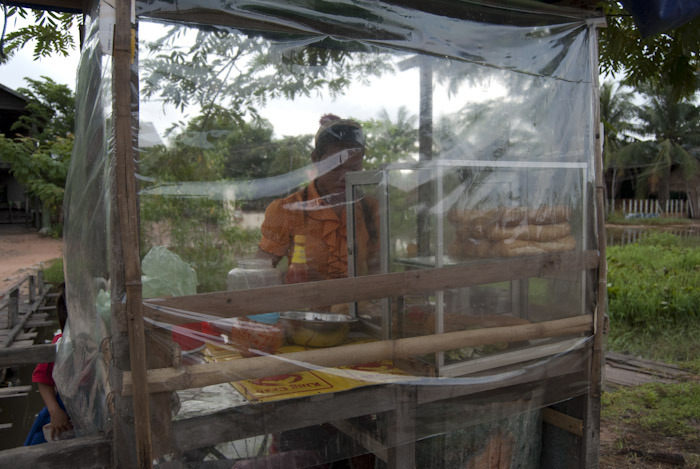
Breakfast is sandwiches at a stand just outside Siem Reap.
West Baray
Our first destination is the West Baray, one of two giant artificial reservoirs (the other being East), each roughly eight by two kilometers. The East Baray is dry, but the West Baray is still partly filled, varying with the season. On our way to the West Baray, we make a whirlwind tour of Angkor Wat and the Bayon, then head out along a dirt road and through the west gate of Angkor Thom.
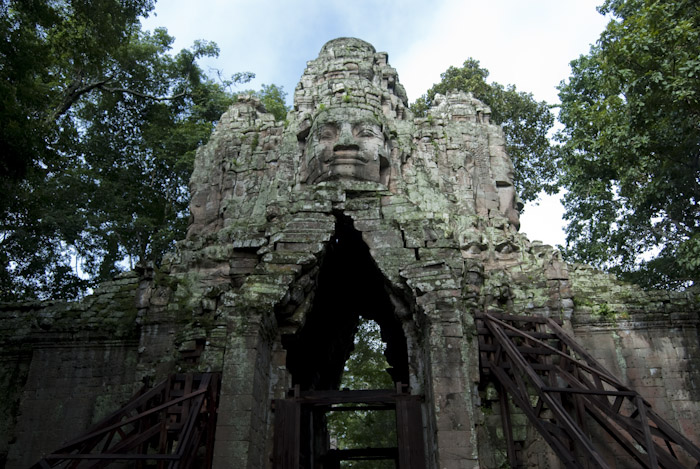
We pass into new territory. (panoramio)
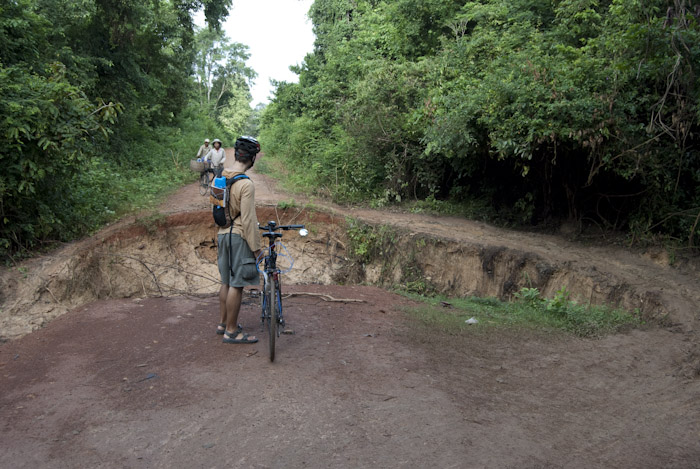
Shortly after the gate, a section of the road is washed out; we opt for the lower (less thoroughly muddy) route around the temporary pond. (panoramio)
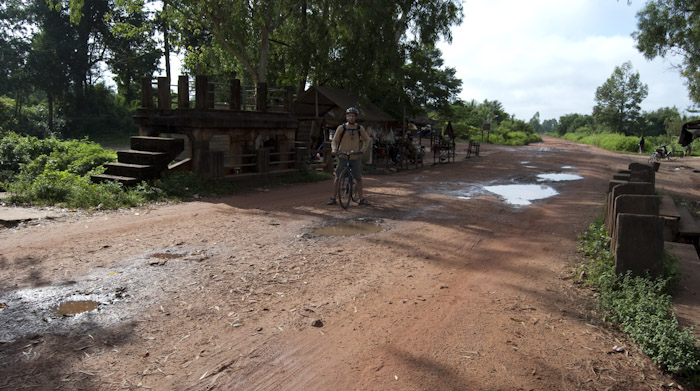
A little further, we come to an intersection. (There is not an obvious giant lake to tell us which way to go.)
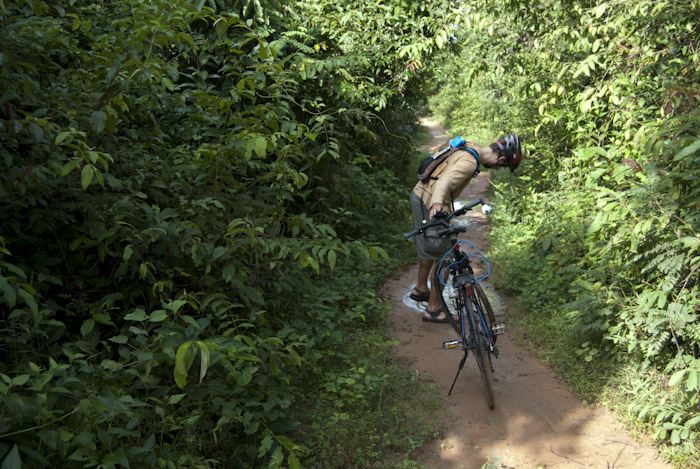
We try the straight-ahead path first, which shortly turns narrow and muddy; we double back to try turning north.
Back at the intersection, we follow the road north, which curves east and into an area with village houses.
After about fifteen minutes, we still haven't seen obvious signs of the Baray. Coming upon a particularly muddy section of road, we decide to ask for directions — an interesting proposition, not speaking the language. We point to the map in the front of the guidebook, asking where we are and saying where we want to go: 'water'. We get to communicating relatively quickly, and are directed a little further down the road, then to turn left at a store; and when we almost miss the turn, the man who we had stopped to ask catches up and sets us right.
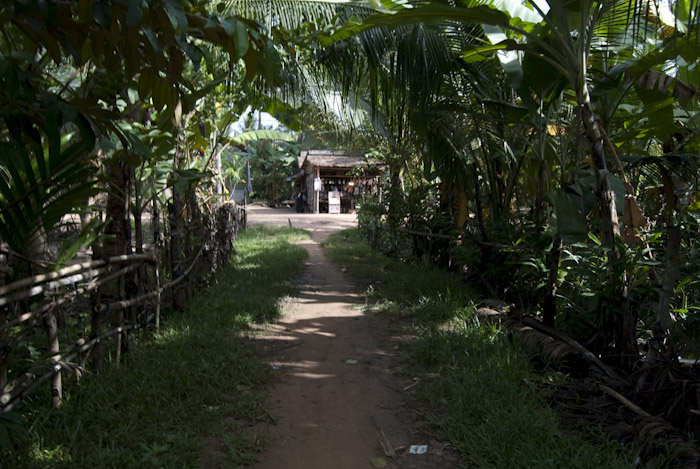
We leave the main road for a smaller path between houses.
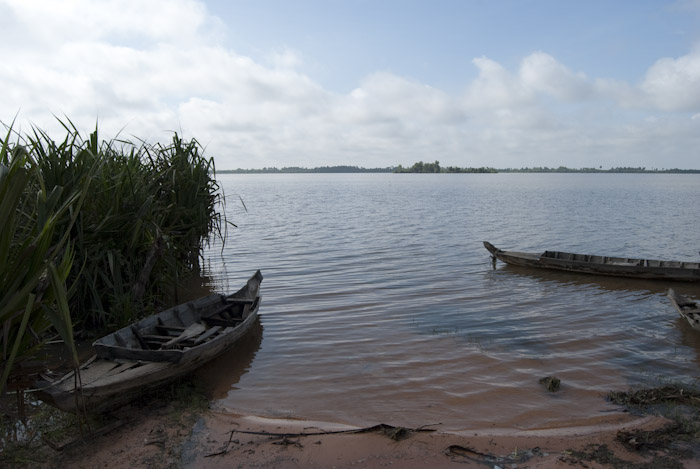
Success! A little way betwen houses, a short ascent, and at the crest of the hill we can see the water. We follow the path down towards it. (The boats are tempting, but neither ours nor entirely watertight.) (panoramio)
We come out almost even with the center island of the Baray, and marvel at its size — it looks like a lake, not an artificial reservoir. From the bank, it does not even have obvious linearity (plainly evident on maps) to give it away. (The island features the West Mebon, but we can't see it from where we are on the bank.)
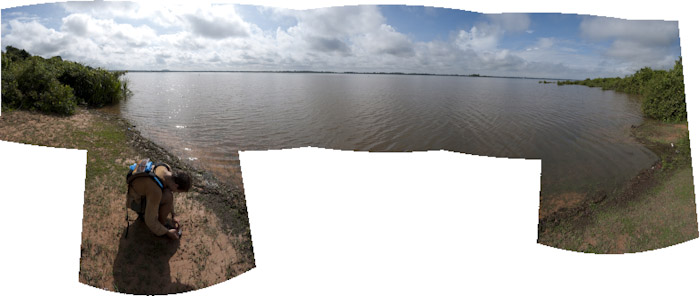
We make our way back to the path along what we surmise to be the artificial embankment around the Baray, then make another foray down a little way back to the east, earning a better view of the shoreline (and a painful insect bite to the foot for Micah). Satisfied (and recovered), we head back along the hilltop path, though it eventually narrows and roughens and we cut back to the dirt road.
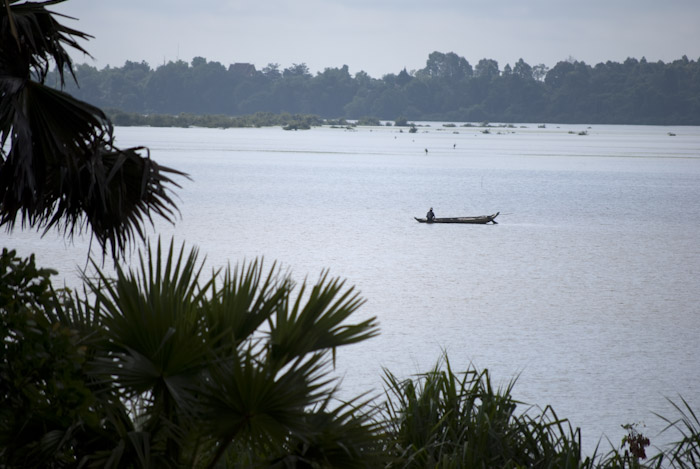
Eastward, plants have begun to retake the Baray.
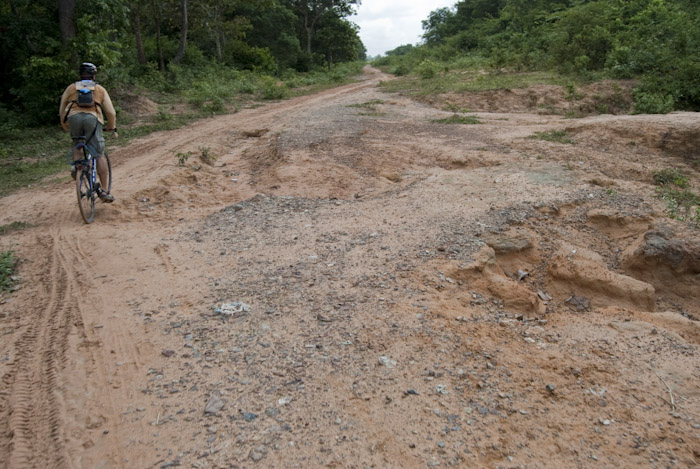
I enjoy a little offroad riding, and am pleased that my bike (though it fishtails a little in sandier sections) handles it well.
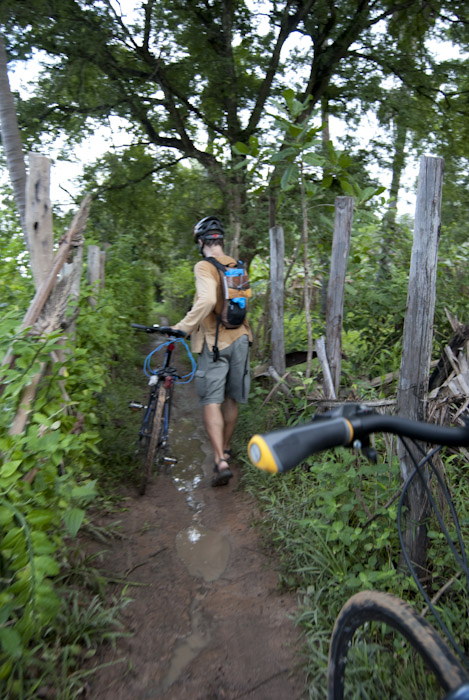
We turn off the ridge road, bump down to and through someone's back yard, between houses, and eventualy back to the way we came.
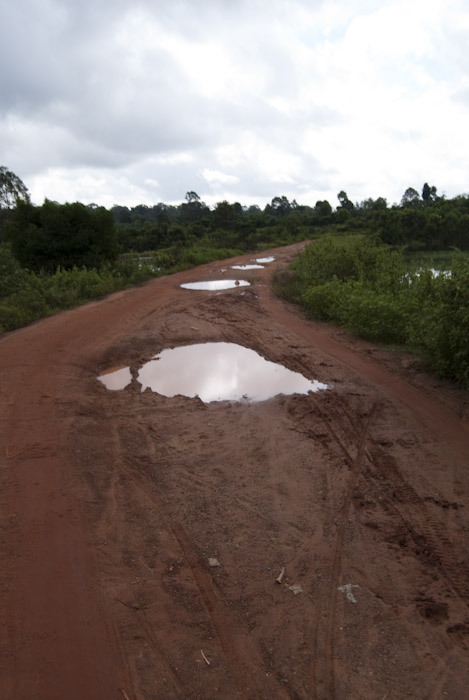
I am a constant admirer or the red dirt road against the surrounding green. (panoramio)
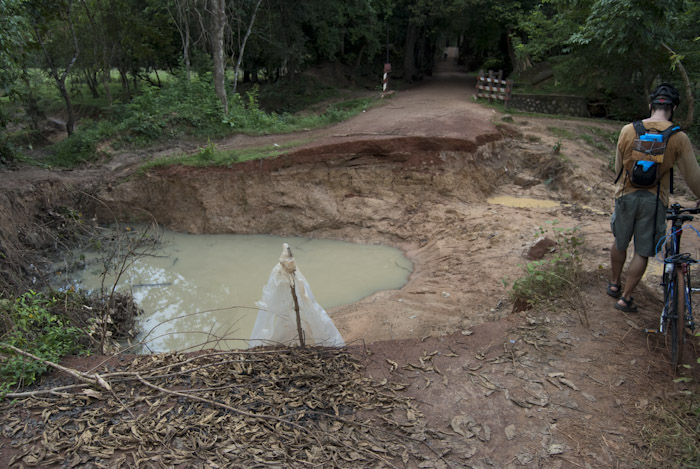
We are back to familiar territory. It is not clear to us how the water carried away so neat a central chunk of the road. (panoramio)
Preah Kahn
The route to our next site, Preah Kahn, takes us back through Angkor Thom; we have second breakfast (not quite elevensies) in touristville. Micah takes the opportunity to have something Western — bananna pancakes — and I opt for pork fried rice.
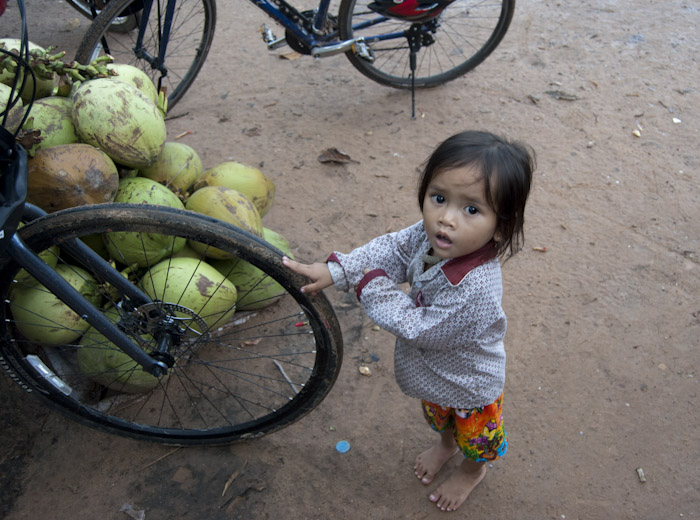
Although we are as usual pounced on by children selling the ubiquitous postcards and bracelets, not all the children are working.
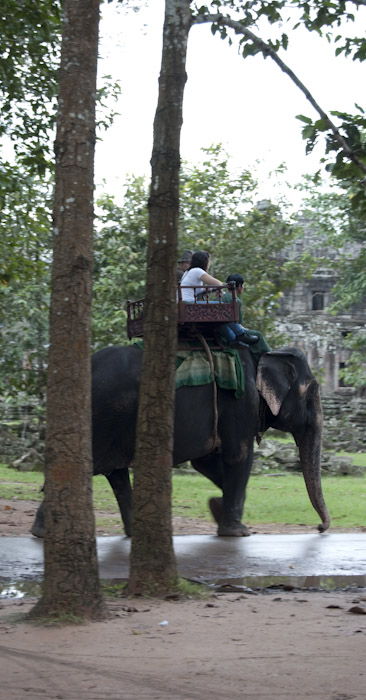
Micah observes that touring the ruins by elephant would be fittingly grand.
Fed, we ride north (with a reprise of the Elephant and Leper King's terraces) and out the north gate of Angkor Thom. (We have collected them all.)
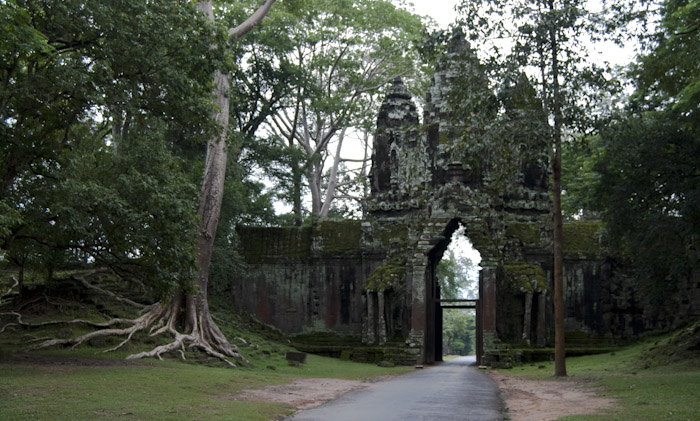
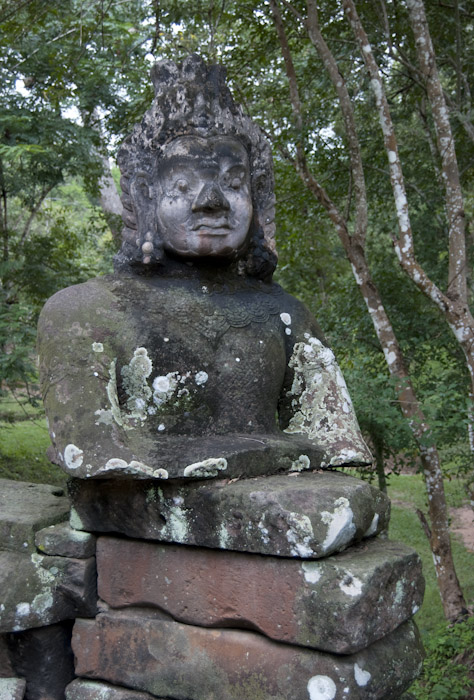
Like the others, the north gate has guard figures lining the road outside. Most of them have had their heads looted (said to bring bad luck), but the occasional one retains its imposing visage.
Preah Kahn has, as are coming to expect, a moat and an impressive outer wall, reached by a causeway. Past the gate, the site is minimally preserved; it has both the interior chambers and corridors that are standard, and outdoor areas with stately raised walkways.
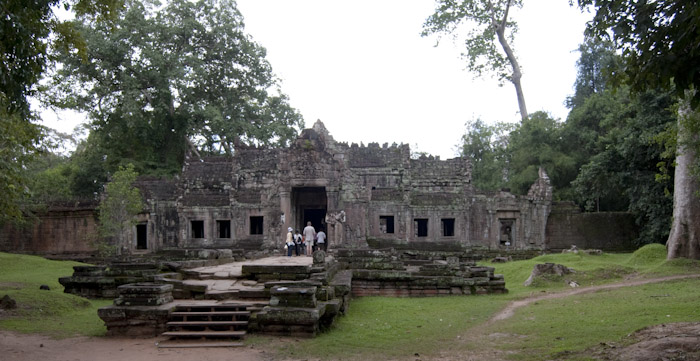
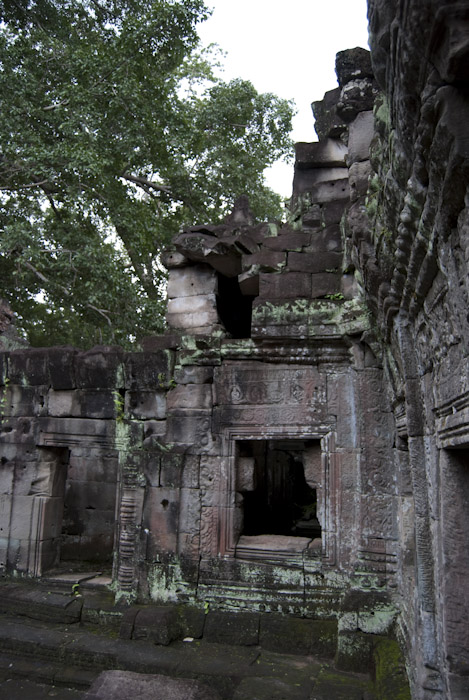
As is standard — and continues to bowl us over — every surface is (or was) intricately carved.
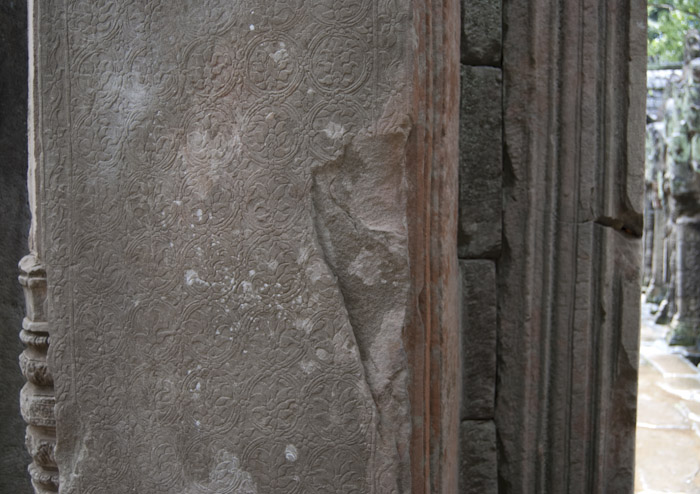
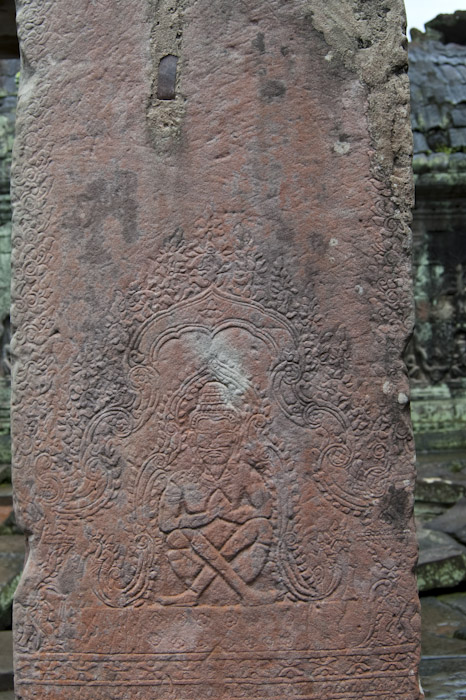
It amazes us that not only is everything decorated, but the decorations continue to be novel in each new location.
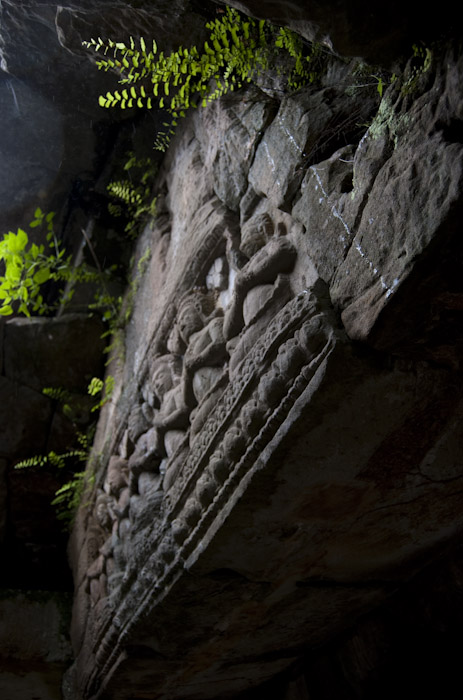
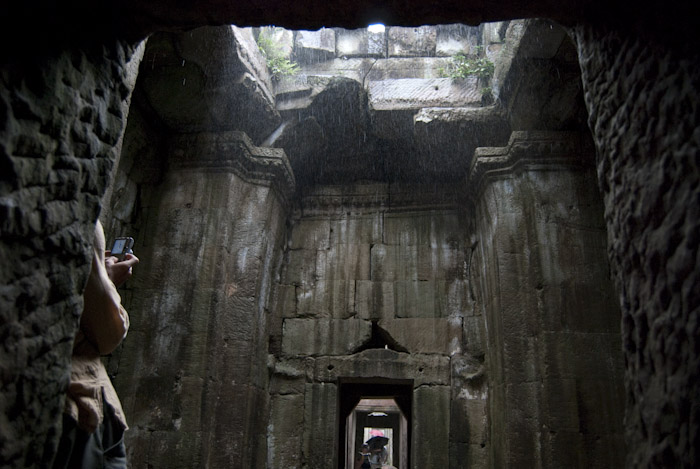
We get an afternoon rain.
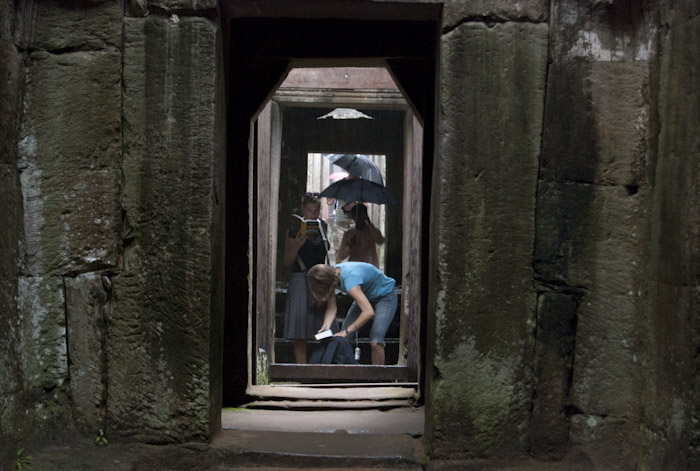
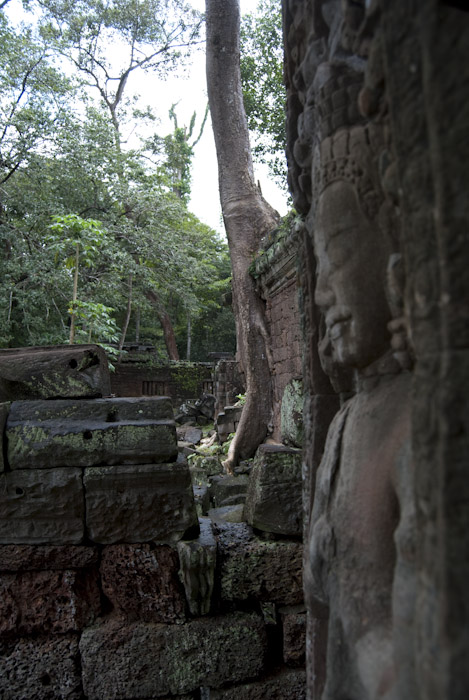
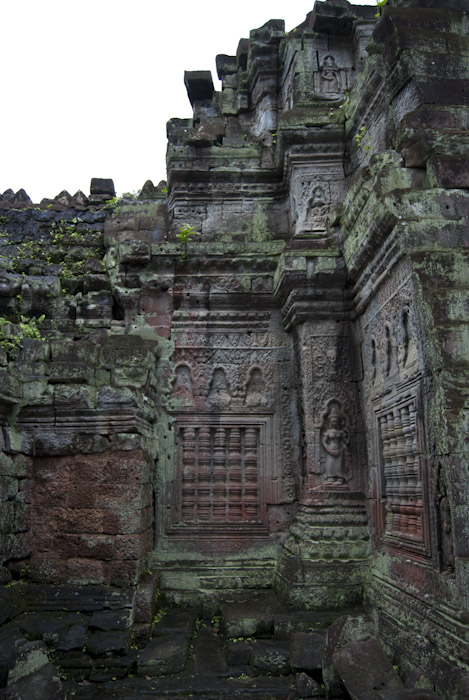
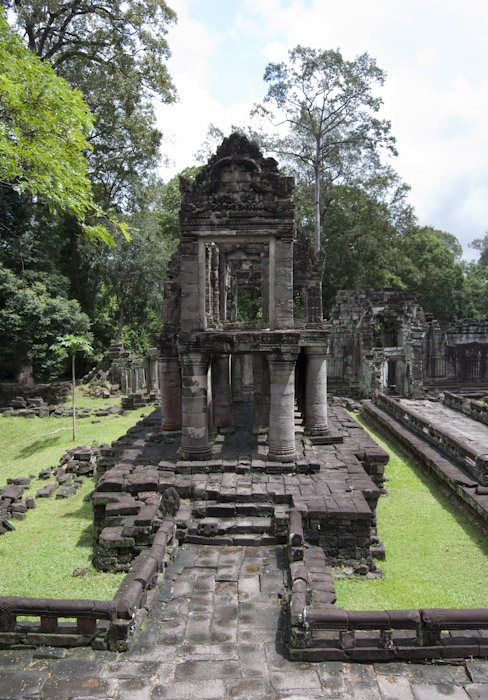
A first for us, Preah Kahn has a two-storied, pillared section.
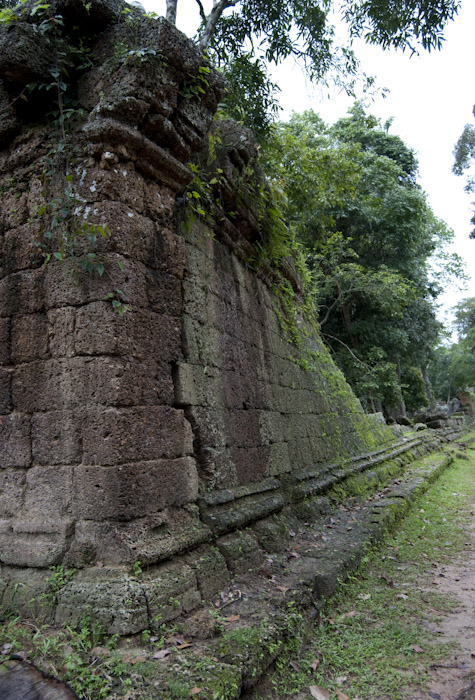
The exterior wall is massive, but partially collapsed.
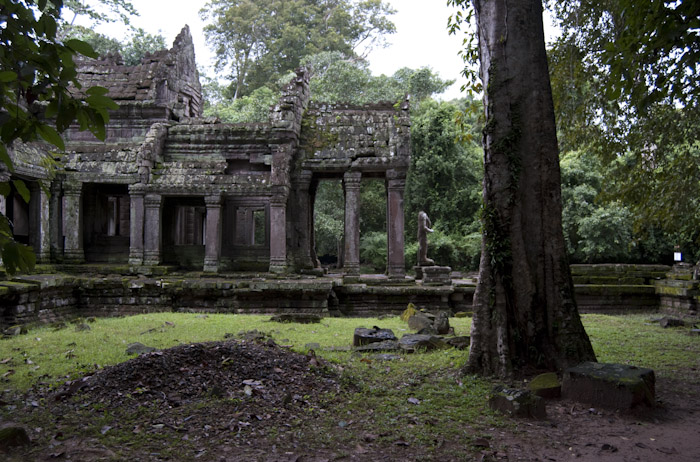
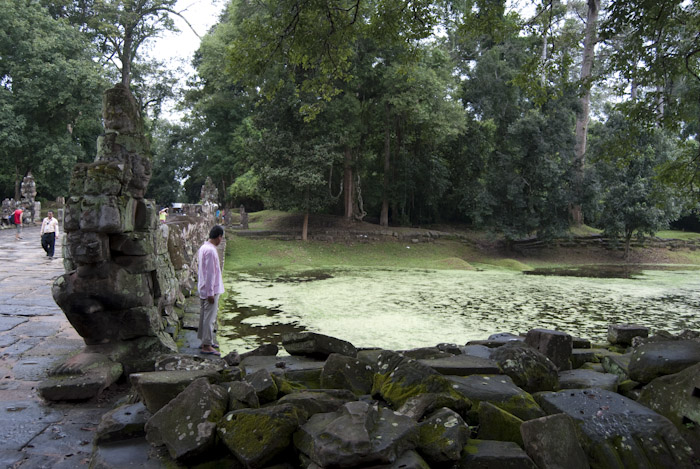
We cross the moat again on our way out.
Neak Pean
Neak Pean is a pleasant, comparatively small set of pools. It has a refreshing garden-like feel. Although the pools themselves are not at high water, the arrival path is flooded, which makes it a fun walk in.
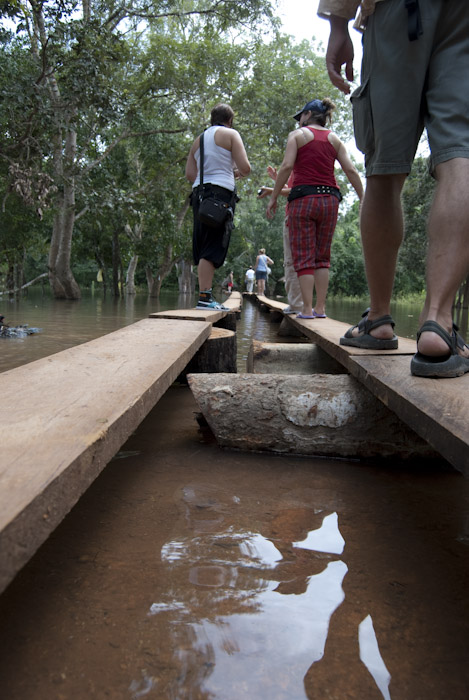
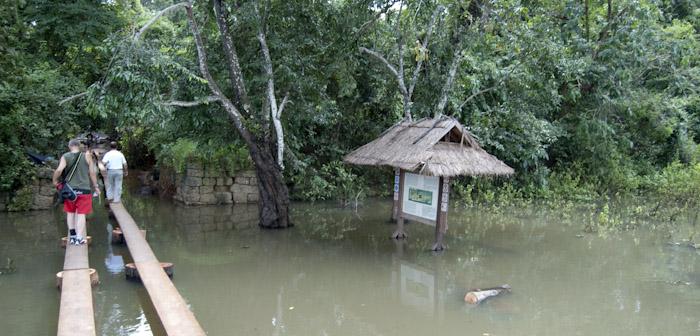
The flooded sign makes it clear this is not the default setup.
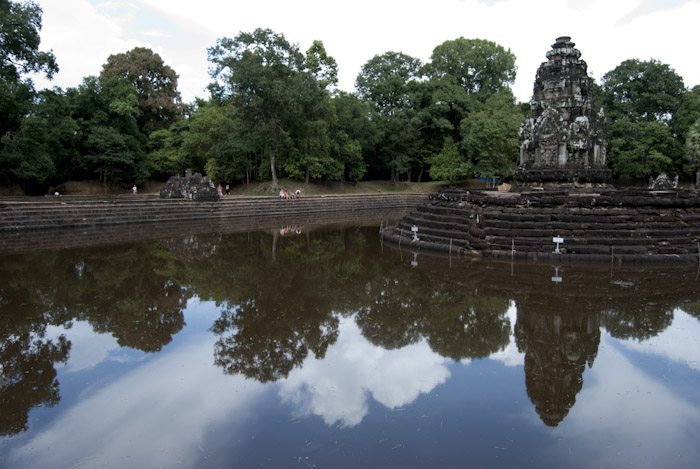
There is a central pool with a tower, with four smaller pools adjacent. They are aligned to the cardinal directions, as are all the temples. (panoramio)
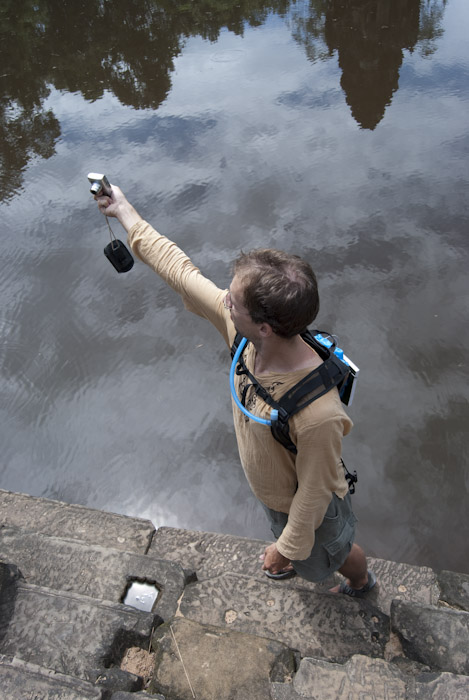
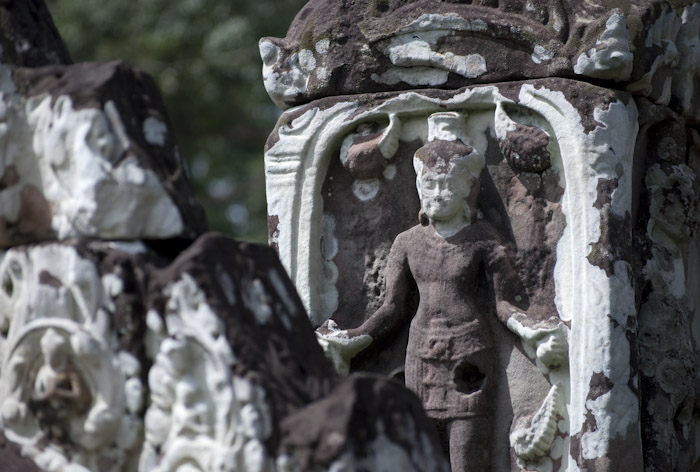
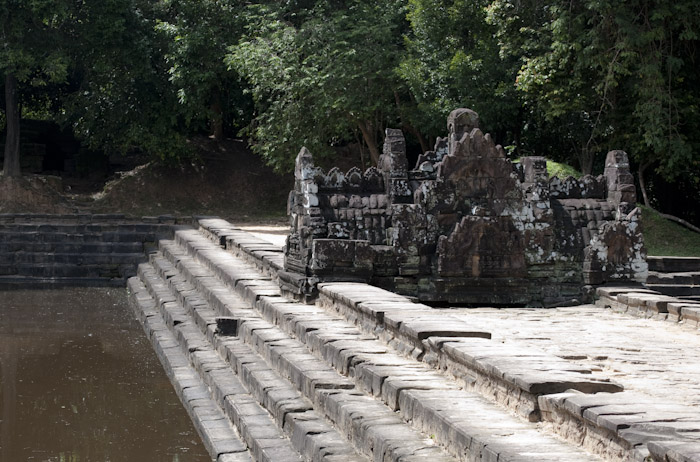
One of the smaller pools has red dragonflies over it, and small frogs which raise up a chorus for a few moments before settling back to the occasional chirrup. It is a peaceful stop.
East Mebon
We bike next to the East Mebon. It is in the center of what used to be the East Baray, the matching artificial reservoir to the one we have seen earlier in the day; this baray is now farmland.
The temple itself features a large raised central platform, and the whole is well above grade — previously, it was surrounded by water.
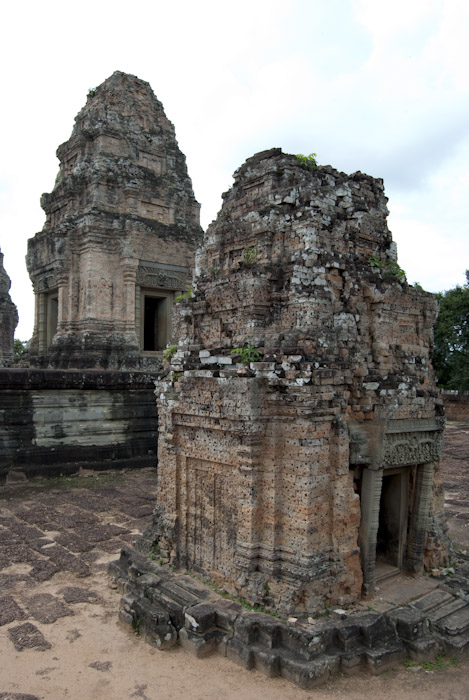
We learn later form the guide book that construction in this style covered a layer of brick with mortar bas-relief — the explanation for why everything is full of holes.
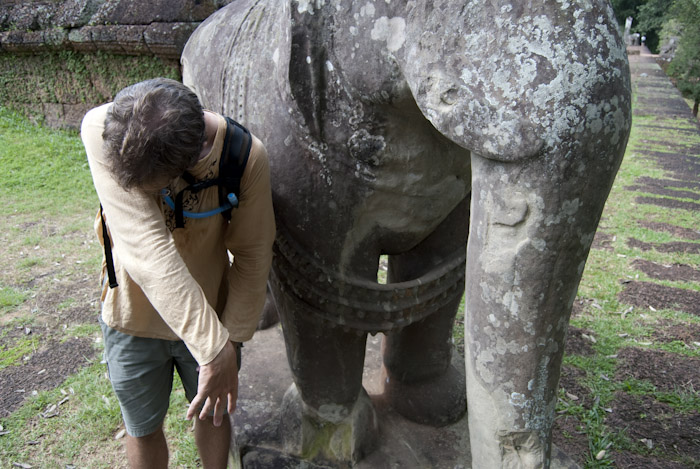
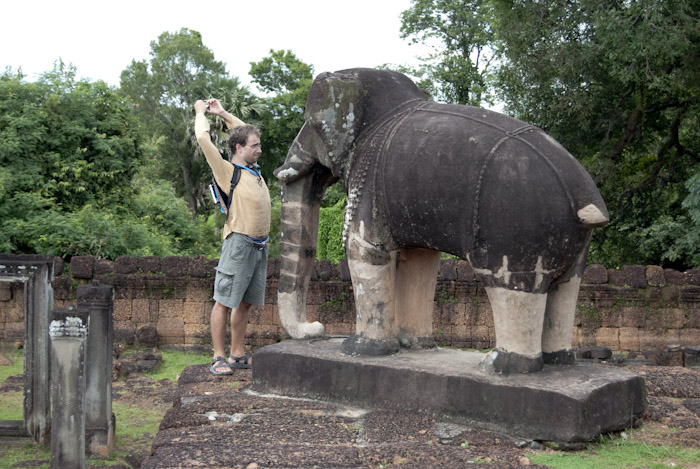
The elephant sculptures are inconveniently placed for mid-distance photography.
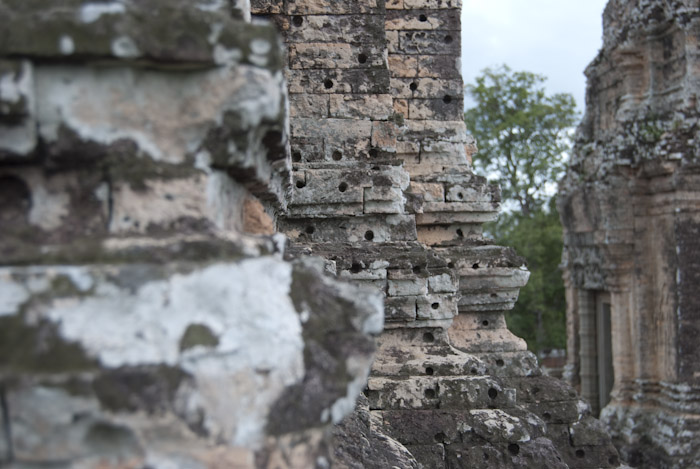
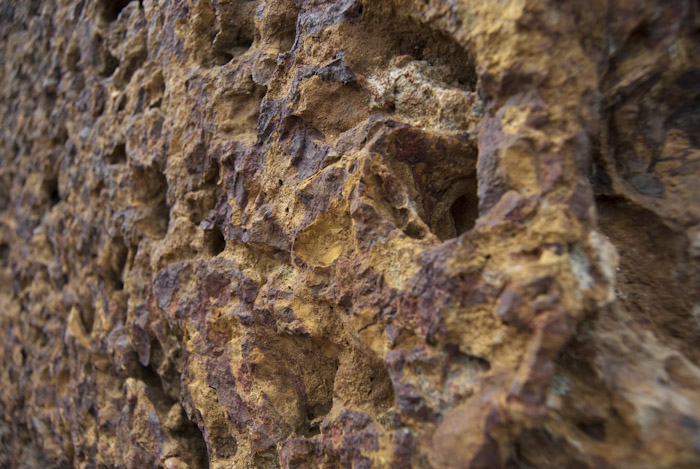
The understructure of this (like other) temple is laterite, now exposed due to weathering.
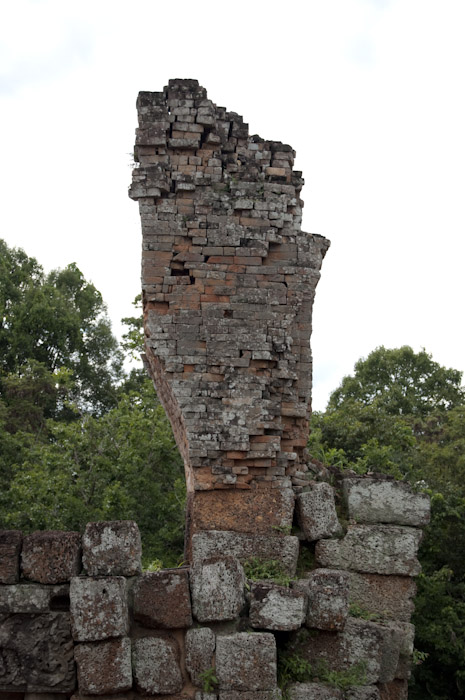
Odd pieces stay standing.
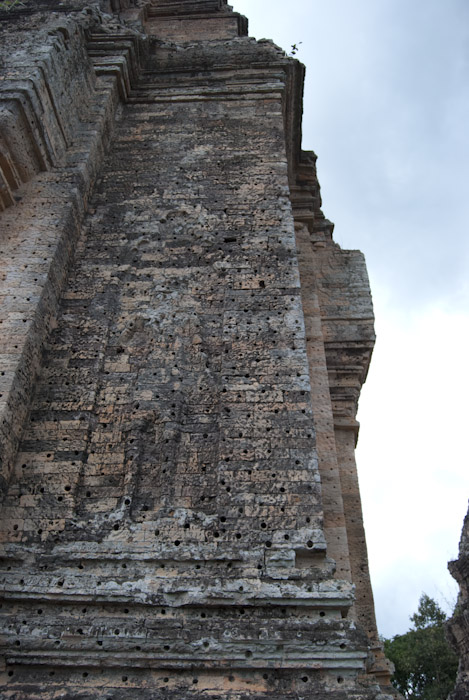
Pre Rup
Arriving at Pre Rup we get a late lunch, then get under cover in the temple as it starts to rain. The temple is similar in construction to the East Mebon: successive raised platforms with towers; laterite and pitted brickwork.
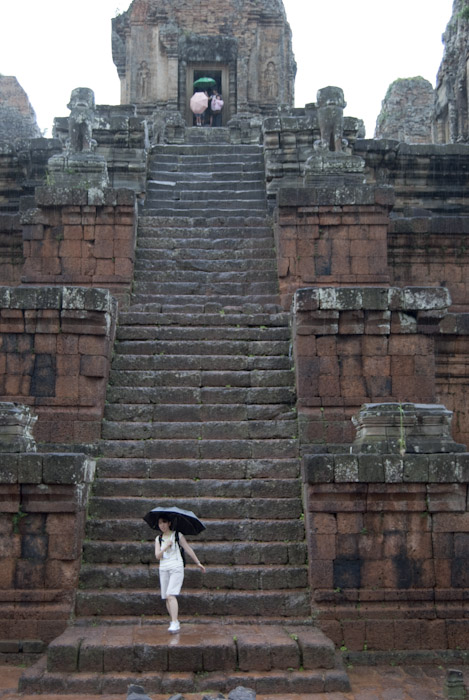
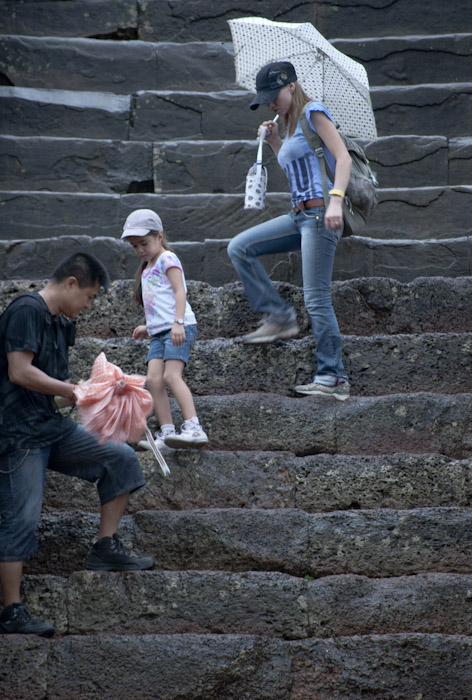
The rain breaks for a moment, and we make our way up the temple, past a waterfall trickling down the steps.
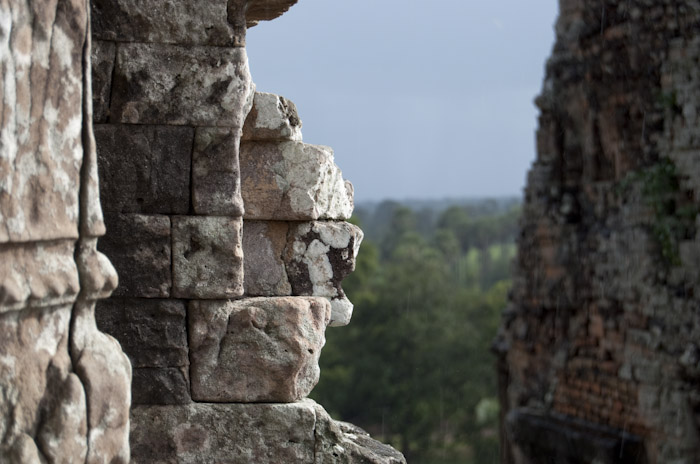
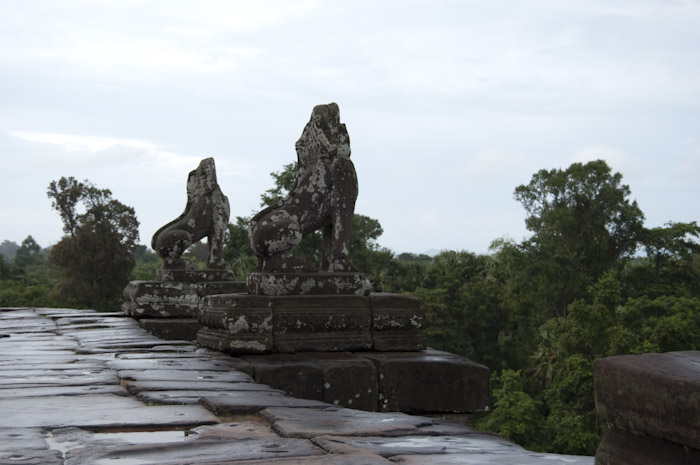
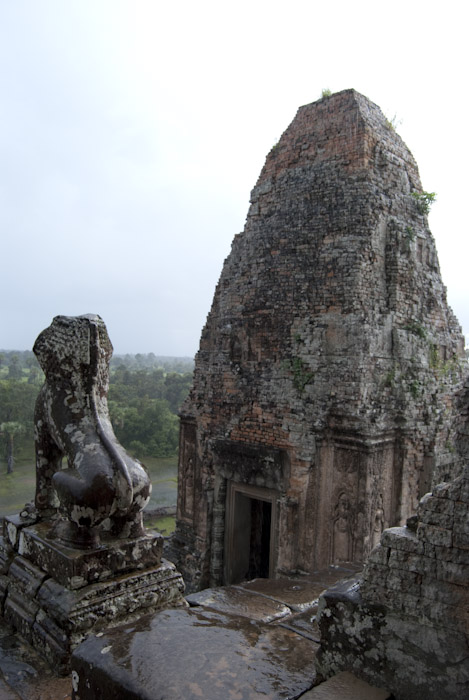
It's easy to feel grand as we sit waiting for the rain to move on, at the top of the temple. (panoramio)
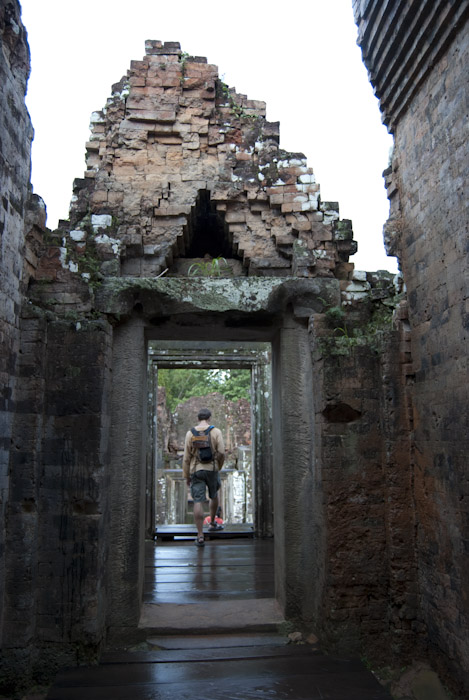
Leaving, we pick up water, then head out to find our final site for the day.
Banteay Samre
We bike to the east, heading for Banteay Samre. We pass an intersection with a collection of shops, see a stray artillery piece in a field, and are nearing a landmark-looking hill which we surmise to be Phnom Bok when we decide it's time to ask for directions; we are directed back the way we came. Passing it again, we find the turnoff for Banteay Samre largely nondescript, but luckily spot it this time.
When we approach the park guards (for a ticket-check), however, they tell us that at 17:30 we are too late. Dusk is approaching, but we expect to have a little time; Micah suggests we take a quick look, having biked all the way out; they agree. We pedal the rest of the way down its road, stash our bikes at a handy tree (free of biting ants, we are conscious to check), and turn to exploring. There are a few other tourists at the site, but not many; we aim not to be the last out, having given a reprieve from strict rules of closure.
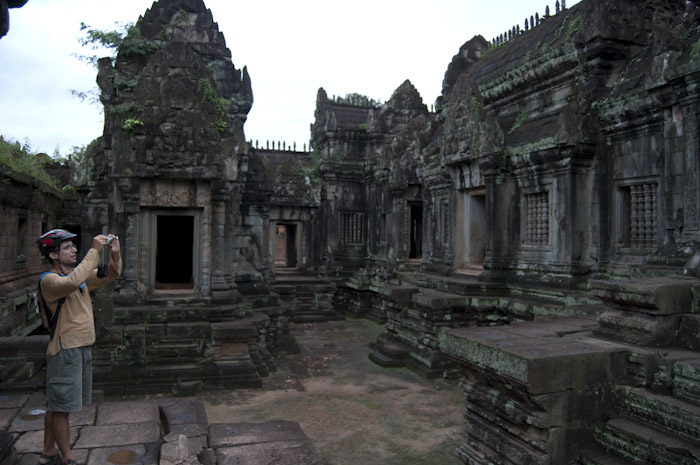
We agree it has yet another new, cool feel; like ornate apartments, with its complex of small chambers separated by balconies and courtyards, with steps down and up between each set. (panoramio)
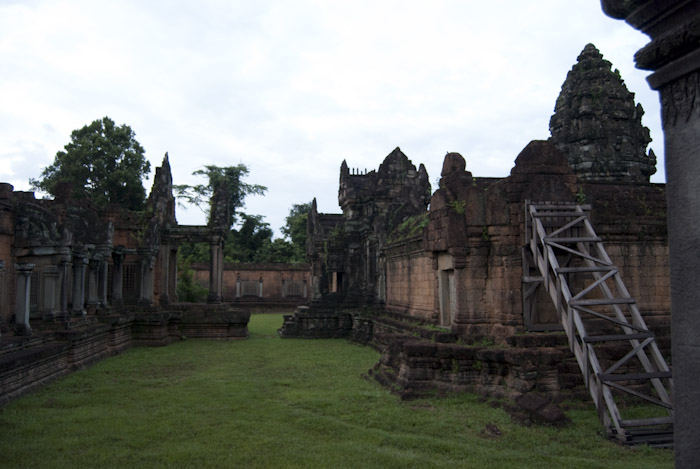
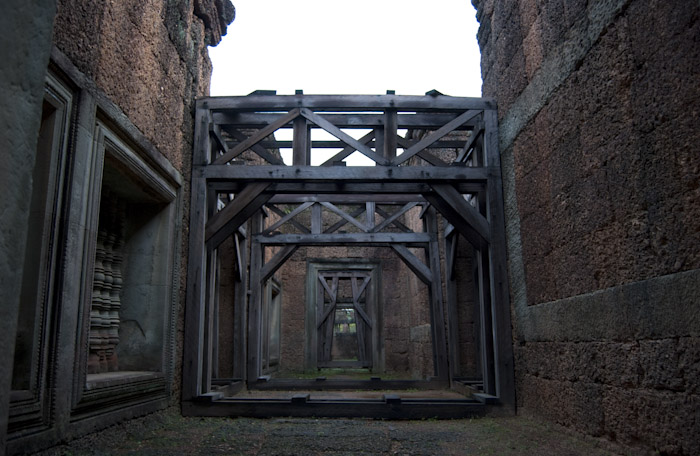
The hallways are particularly full of dark wooden support structures. (panoramio)
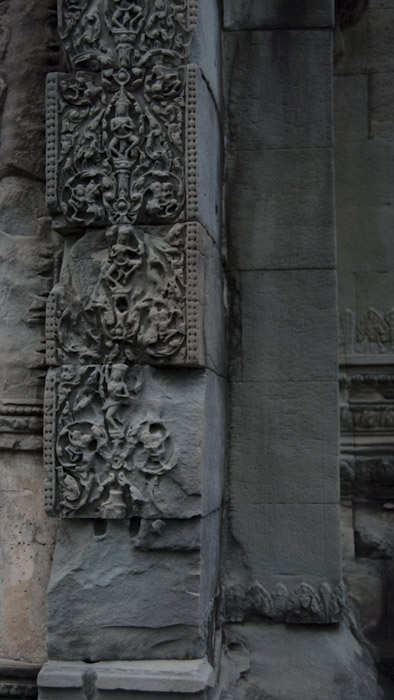
We leave just as one of the guards is coming down the road, likely to check that we're not lingering too long. It is a brief tour of the site, and we could easily have spent longer, but at the finish of a full day of sight-seeing it is alright.
Evening
The sun finishes setting as we ride back to Siem Reap and the hotel.
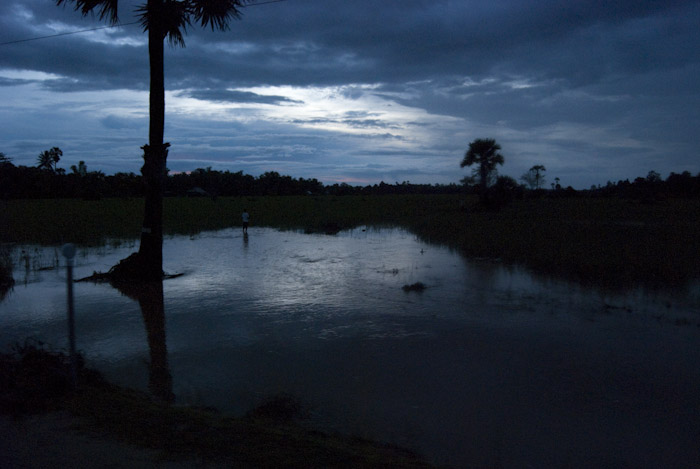
Riding in the dark, I get a freak insect bite on the foot; it feels like a yellow-jacket sting, and I band-aid it for psychological comfort. As the evening deepends, we get lots of gnats to the face — unsurprising, as we are riding through what is essentially swampland, but no more pleasant for expectability.
For dinner, we try a very slightly fancy Chinese restaurant: open-fronted and with a bare concrete floor, but in-building. As we deliberate in front of it we are shown to a table, and discover that the menu is entirely in Chinese and Khmer: no English, and no ability to communicate with the waitstaff. We are on the verge of leaving when a phone call one of the waiters had made bears fruit, and a high-school age boy arrives. He translates for us, and sits with us to talk while we wait for our food.
He is easily conversant in English, chats with Micah in Thai as well, and even exchanges some French with me briefly. I am encouraged to hear that this last is a common language among the older generation, and with tuk-tuk drivers, though the hope of using French never bears fruit. It is also from him we learn the distinction between Cambodian (political) and Khmer (ethnic and linguistic).
The food is good, and despite choosing a fancy restaurant we are charged below-menu prices; 10,000៛ (about $2.50) for us both.
Although each leg is only a modest ride, our route for the day has taken us about 63Km (plus or minus detours and unmarked dirt paths) — about the same as our first day's ride from Ubon to Si Sa Ket.
Angkor: Far Sites by Tuk-Tuk
For our last day, we take a tour of the more outlying sites, again hiring a tuk-tuk for the day. We are up around six, and after applying sunblock and bug repellant, head out in search of breakfast. I — having seen them earlier — am on the lookout for bread things, and Micah spots a boy carrying a basketfull on his head; surprisingly, he changes a $20 for us (calling on some nearby adults to aid the endevour), and charges us $2 for four pieces. We have two slightly sweet, pita-shaped breads with sesame seeds; and two flakier, greasier pastries with meat filling.
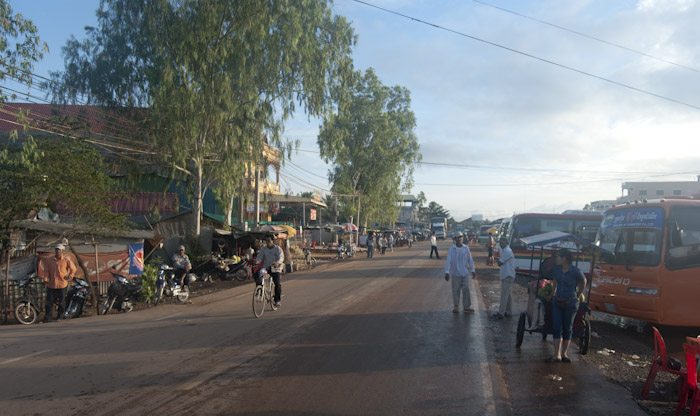
Contrary to previous experience, it takes us a little wandering around to find a tuk-tuk driver for the day. Given the distance we want for to travel, the price is $20; our driver won't be argued down, and it being a reasonable argument we go with it.

Bakong
Our first stop is Bakong, east of Siem Reap. It has a suitably grand moat, the path across which is appropriately guarded with naga, but what impresses me is that the sky and time of day have conspired to treat us with well-lit stone against a comparatively dark sky: photographically, a treat.
Preah Ko
Second in a clump of three, we visit Preah Ko. It is under active restoration while we are there, with workers rebuilding and refinishing the exteriors of the towers.
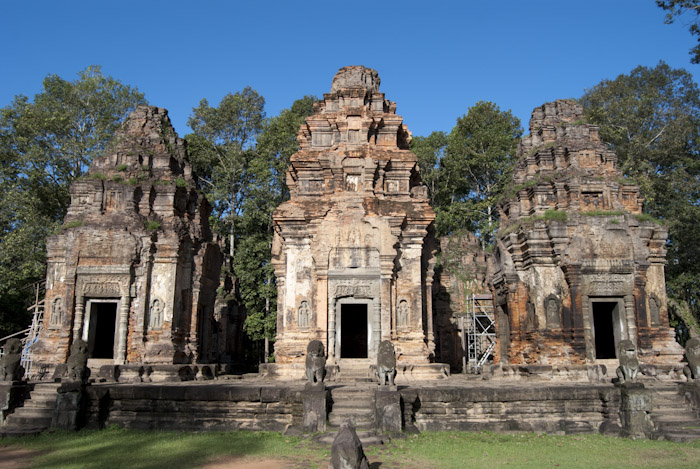
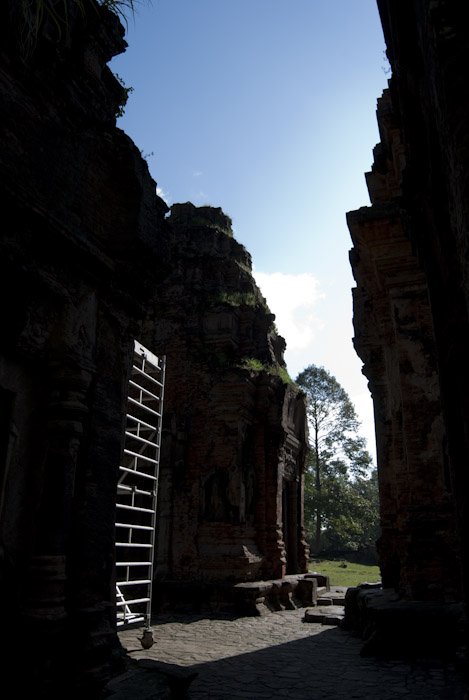
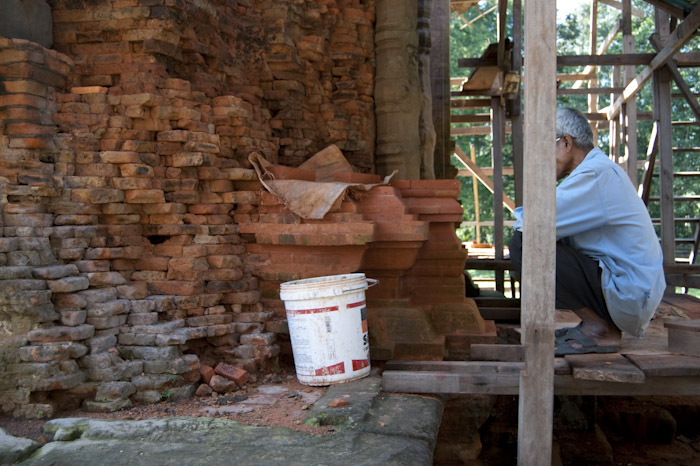
I am surprised by how deep the brickwork is, though comparison with a less eroded tower confirms the restoration's accuracy. (panoramio)
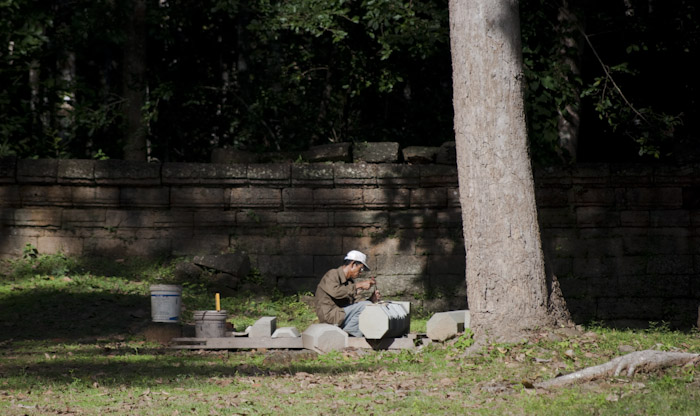
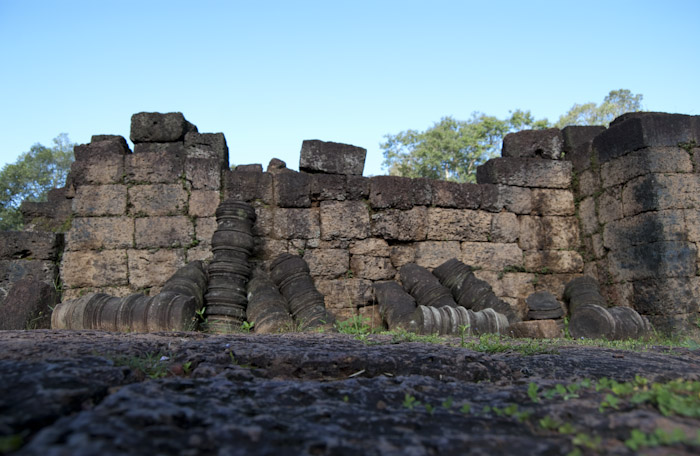
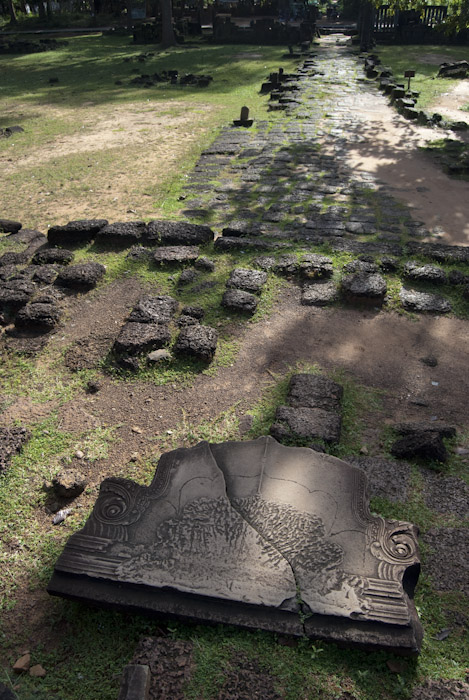
We notice the same style of flourish for stone steps here as at Bakong, the previous site; here, detached from any stairway. (panoramio)
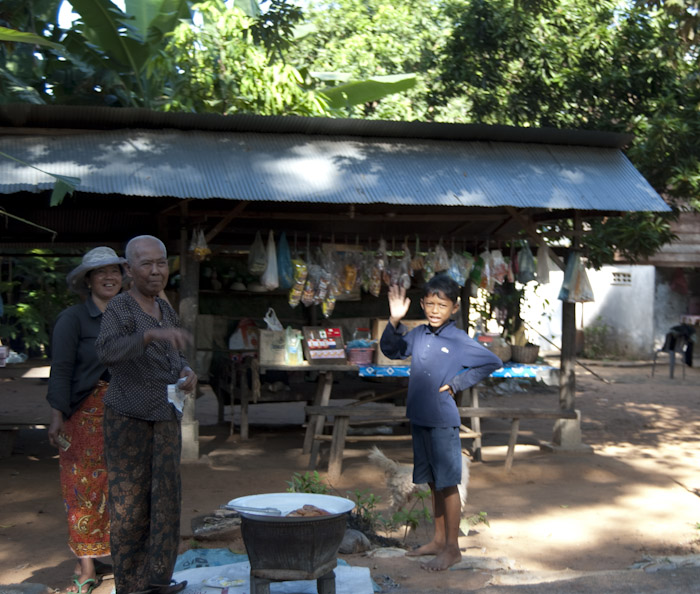
Before continuing to our next stop, and in favor of the ready tourist-oriented vendors, we make a stop for fried fruit snacks at a shop down the road. (panoramio)
Lolei
Last in the cluster is Lolei, a set of four comparatively modest but significantly crumbled towers. Neighboring the temple ruins are a number of monestary buildings; the whole group is on a raised area of land.
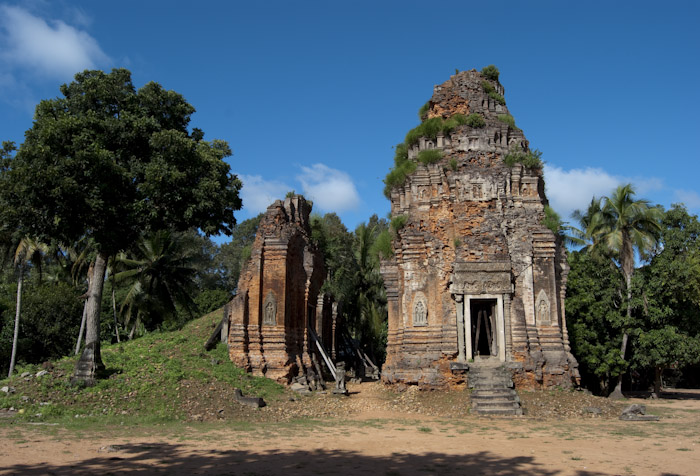
I do not notice until Micah points it out that the hill next to the more crumbled towers (on the left) is probably composed largely of bricks. (panoramio)
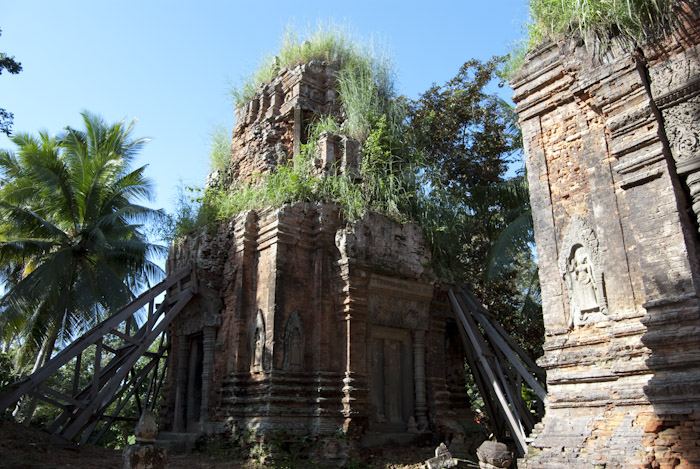
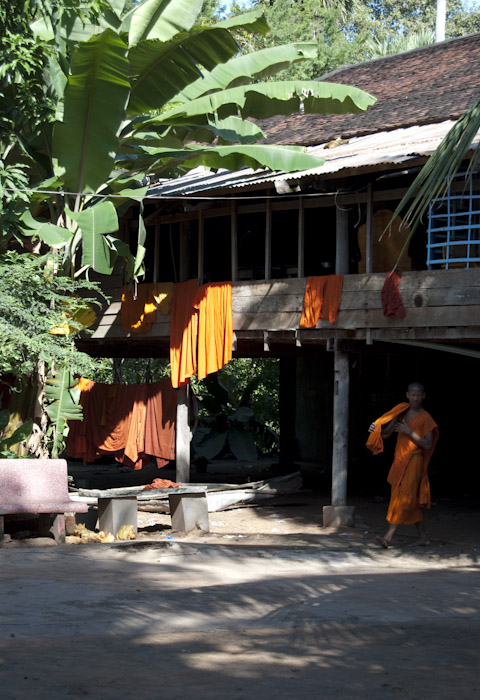
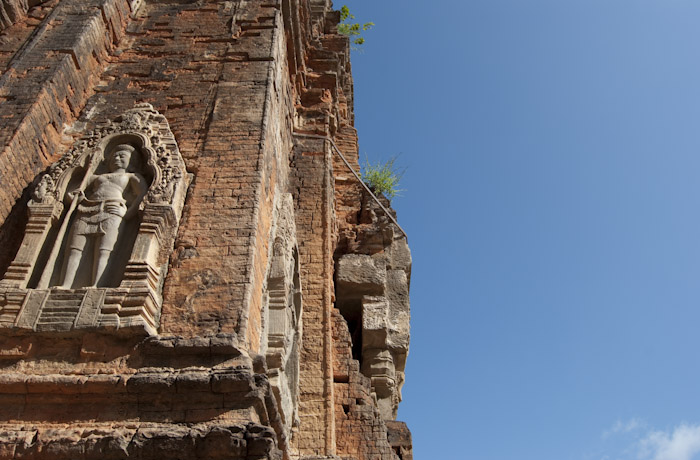
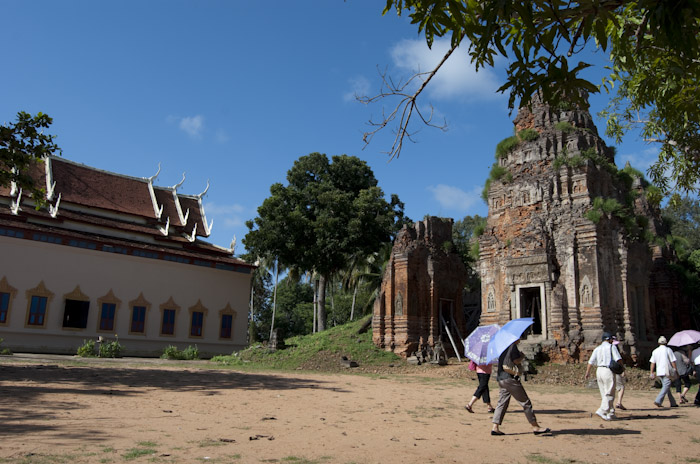
Kbal Spean
On our way to the next site, our tuk-tuk driver becomes concerned about a troublingly squeaky wheel. We make a stop for repairs.
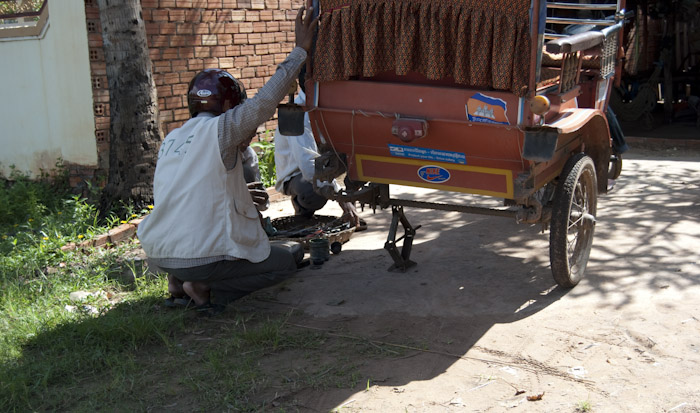
Micah reads the guide book; I take pictures.
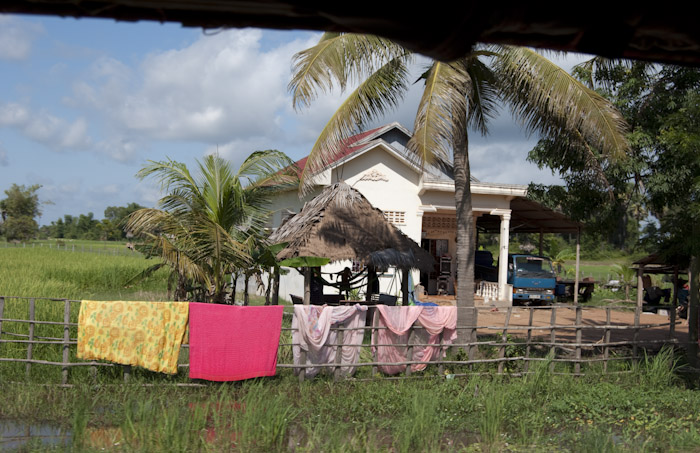
We are back on the road before too long.
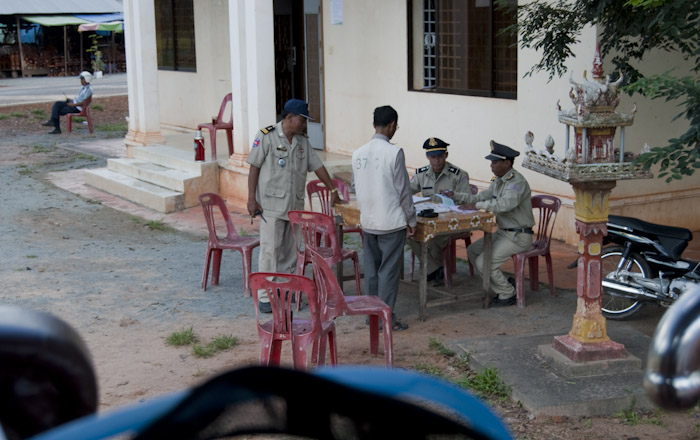
We hit another snag when our driver goes around the wrong one-way side of a trianglular intersection; we wait while he is fined at the police station, conveniently located in the center of the same.
A few stops and some driving later, we make Kbal Spean at a bit after eleven. Although it is tempting to think of how far we are along our eventual departure route (now significantly north of Siem Reap), it is convenient not to have baggage or bikes to worry about — not to mention getting our bikes to the site, by tuk-tuk or otherwise. (A padded seat is still a nice rest.)
Kbal Spean is a set of carvings in a streambed; it is about a half hour's pleasant but strongly uphill hike to the main carvings, and then we follow the streambed down for a few more before hiking out.
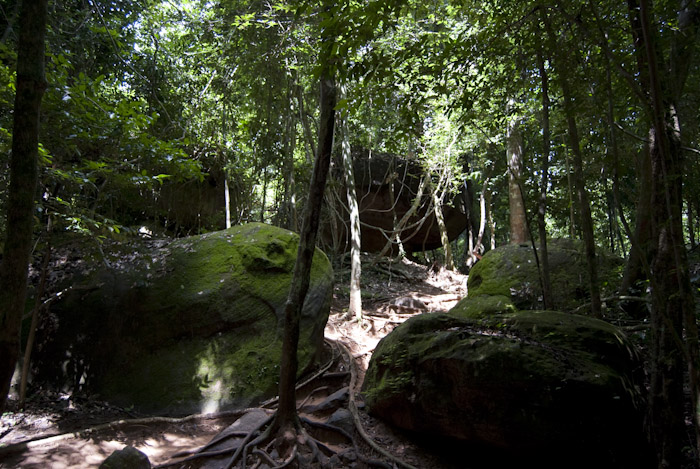
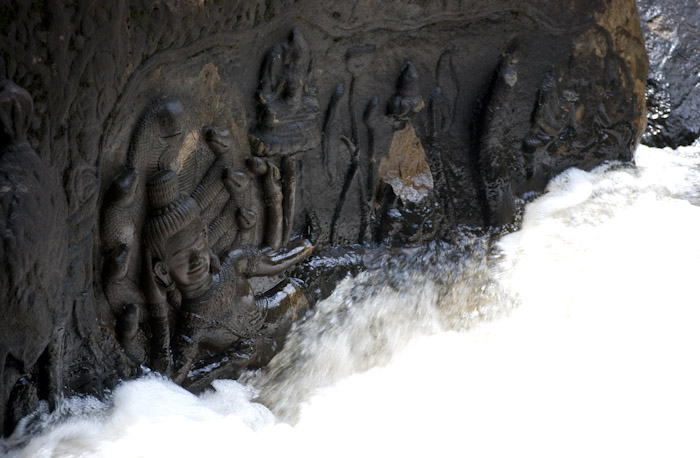
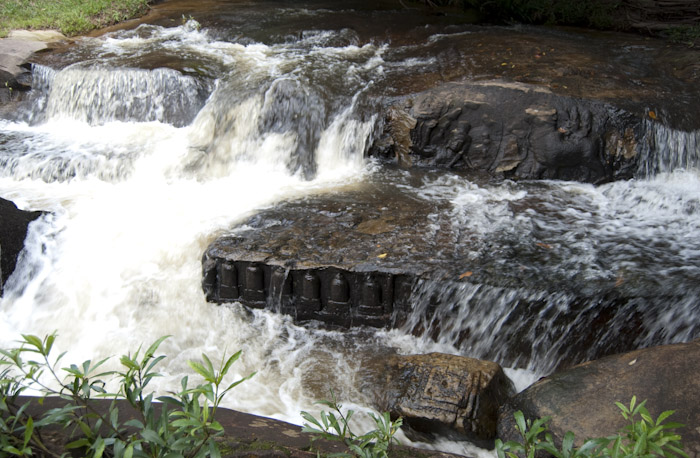
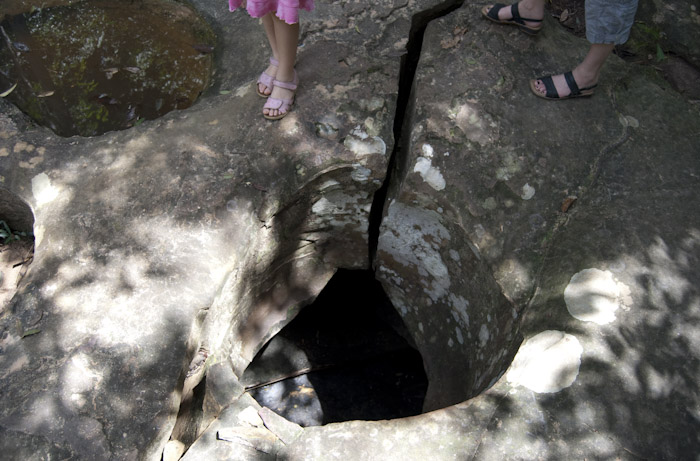
The main carvings are in (at the end of the rainy season) an area of rapids; just below them, the river disappears under a giant rock slab, reappearing shortly on the other side.
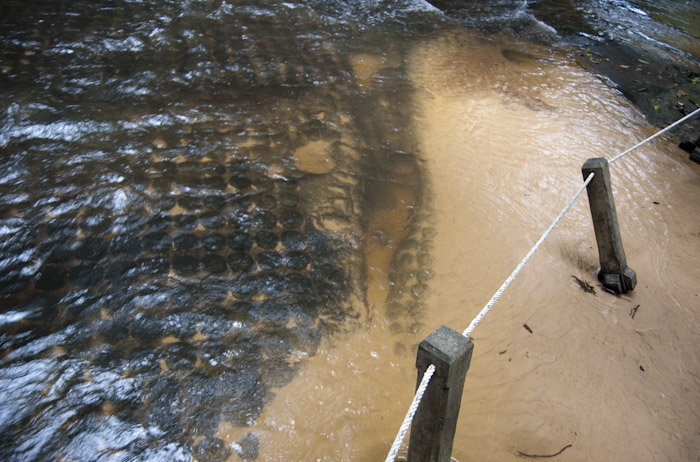
The alternate name for the site is the Valley of 1000 Lingas; these are a few.
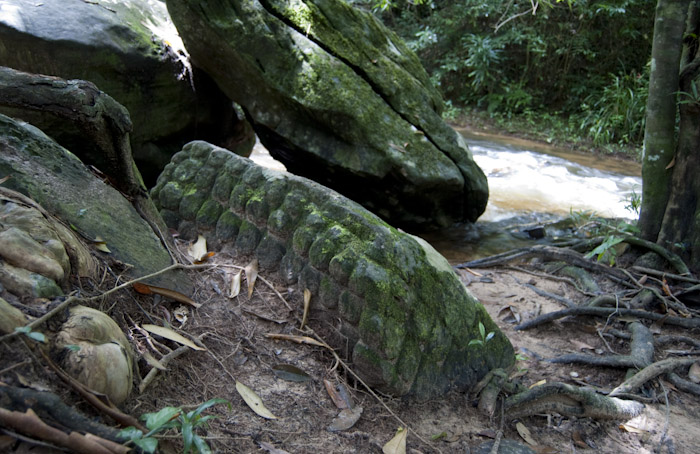
Not all the carvings are (still) in the river.
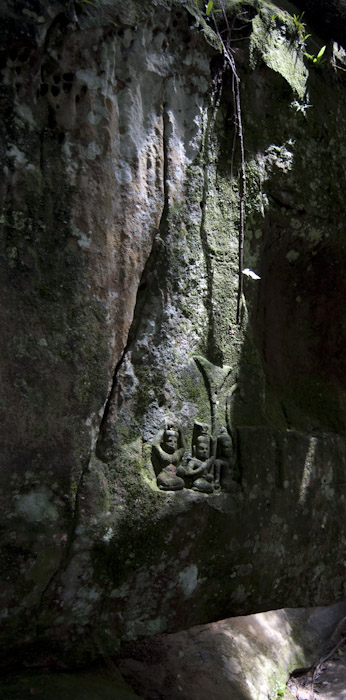
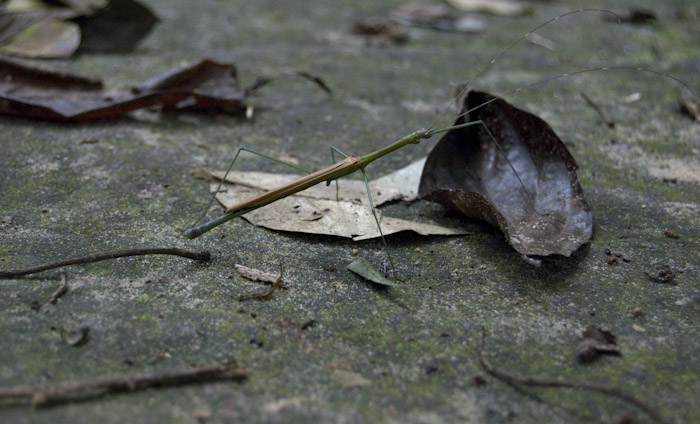
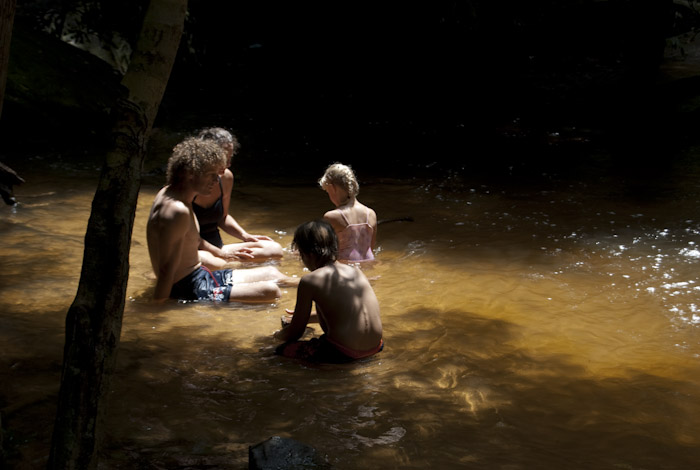
After the end of the carvings, there is a small waterfall, and below that a wide, shallow area.
It is easy to understand why this site was not (re)discovered until 1900 — not only is it somewhat remote from other sites, but up a fairly steep ascent, and often underwater. Both in spite and because of that, it seems to us like an especiall exciting one to discover.
Banteay Srei
Our final site — for the day and for the trip — is Banteay Srei. The guide book informs us (rightly) that it has impressively detailed and intact carvings (in fact, it even has signs saying not to touch them, which is a first); and that it is on a smaller scale than the other temples, feeling almost miniature. We are arriving at one of the recommended times: late afternoon, when the sun will emphasize all the bas-relief.
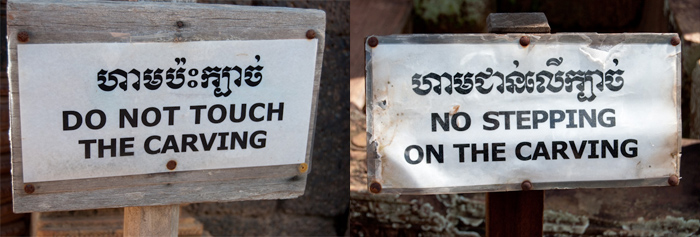
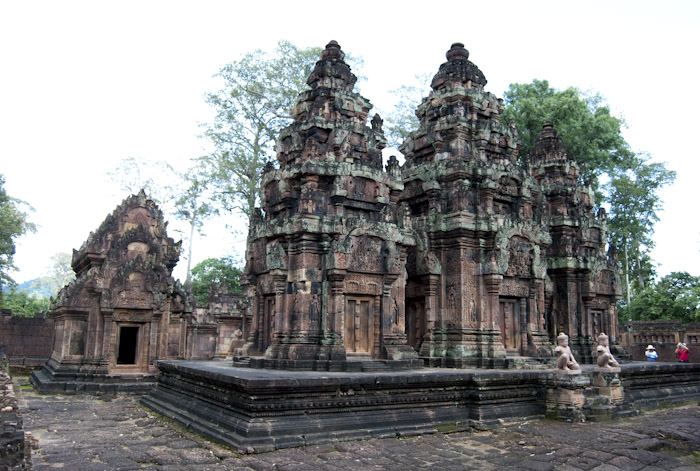
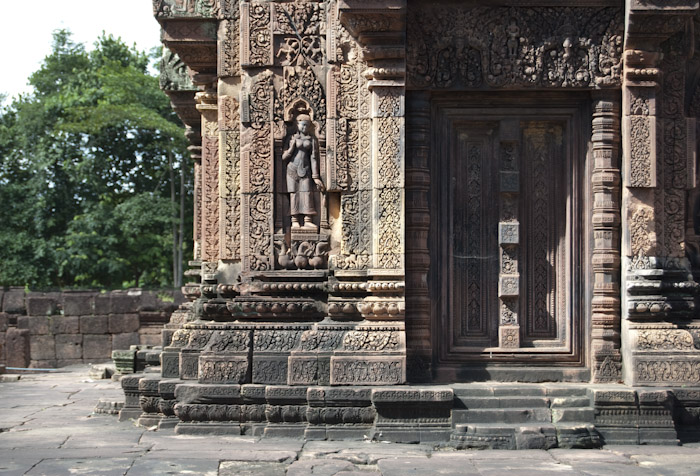
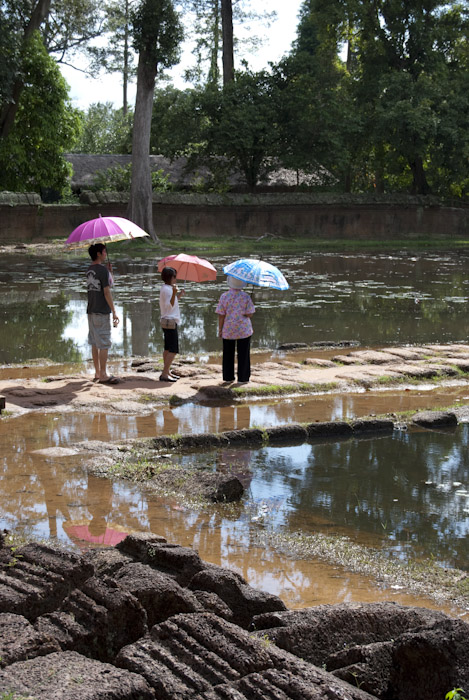
It is hot in the sun.
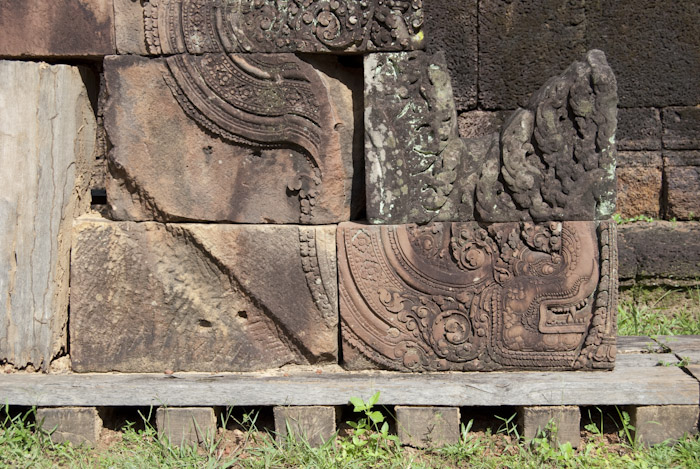
Around the periphary, there are re-assembled sections on blocks.
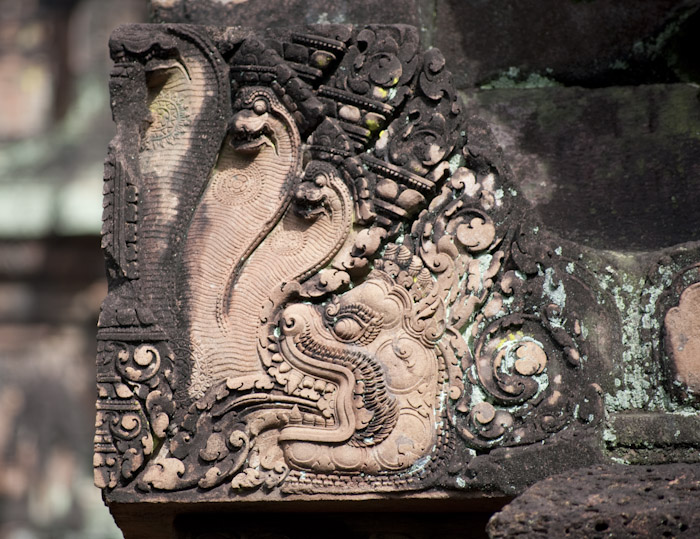
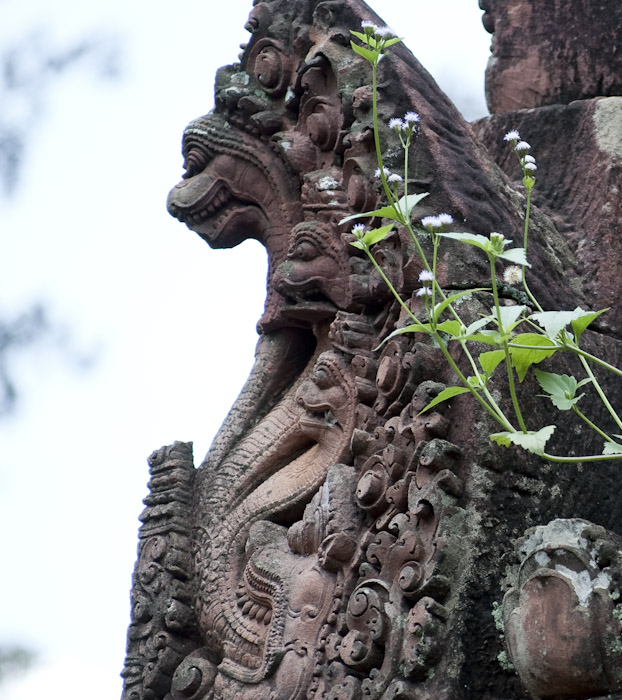
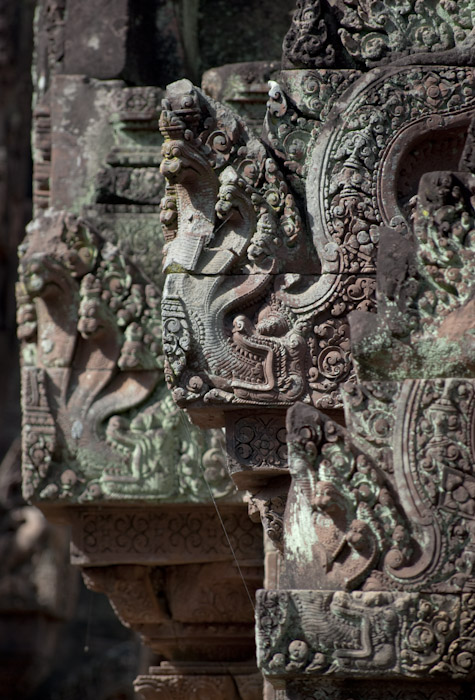
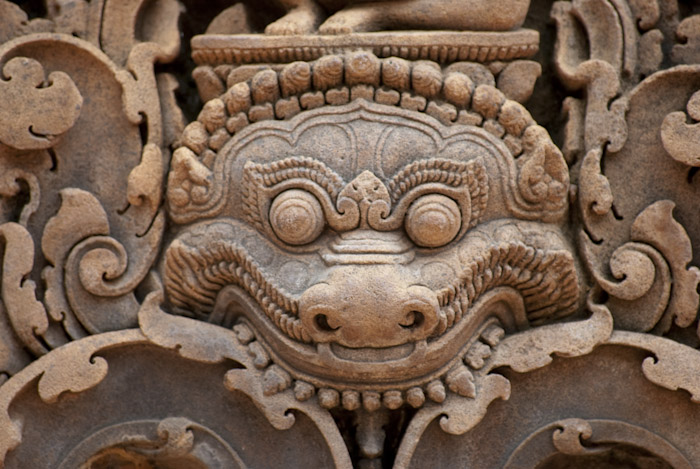
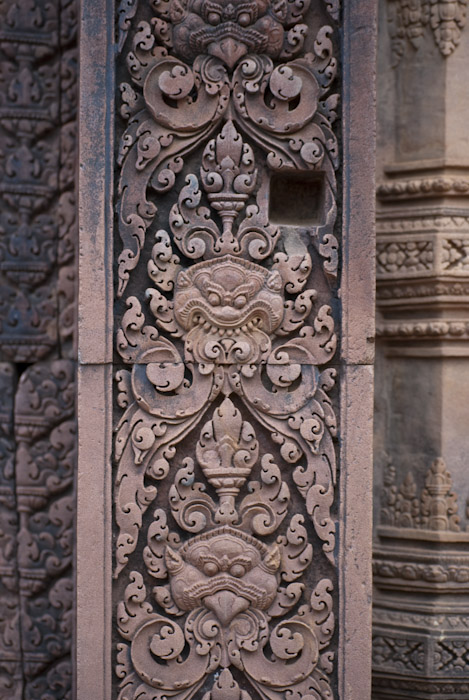
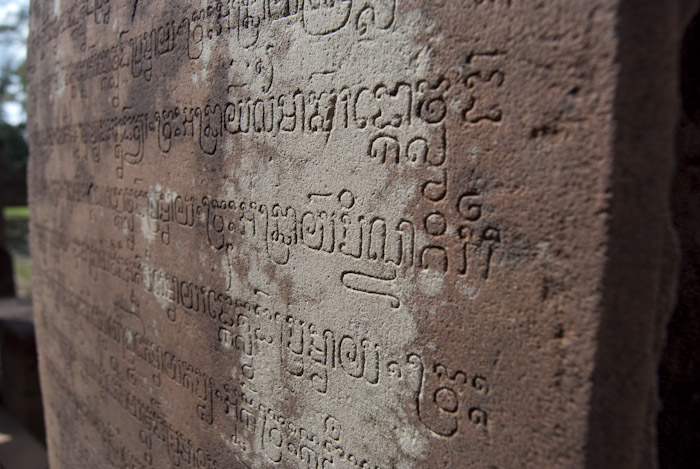
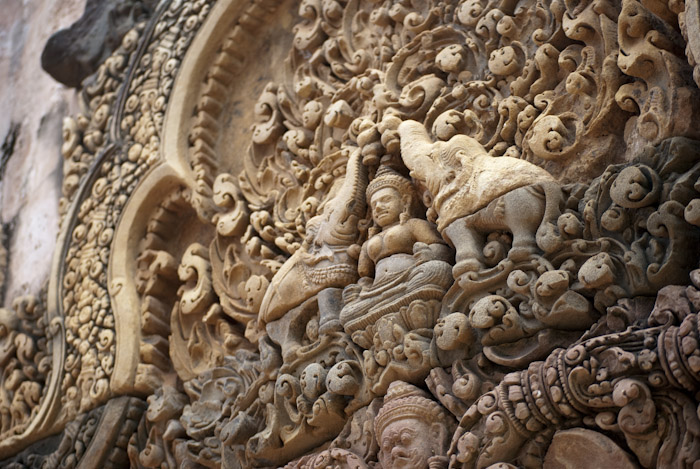
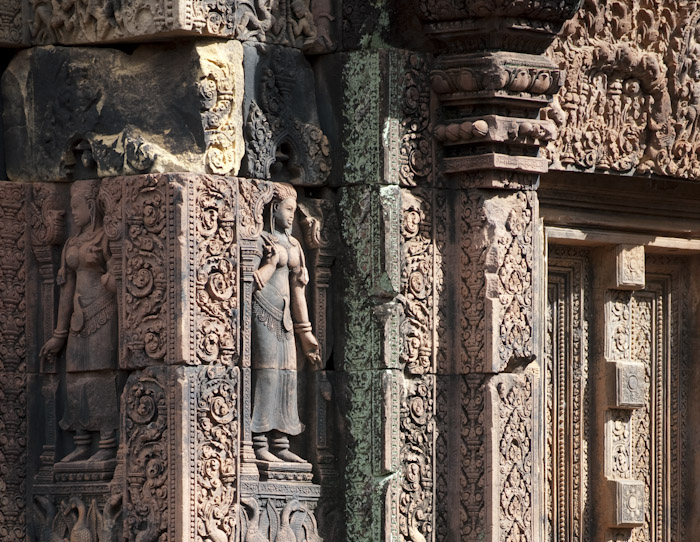
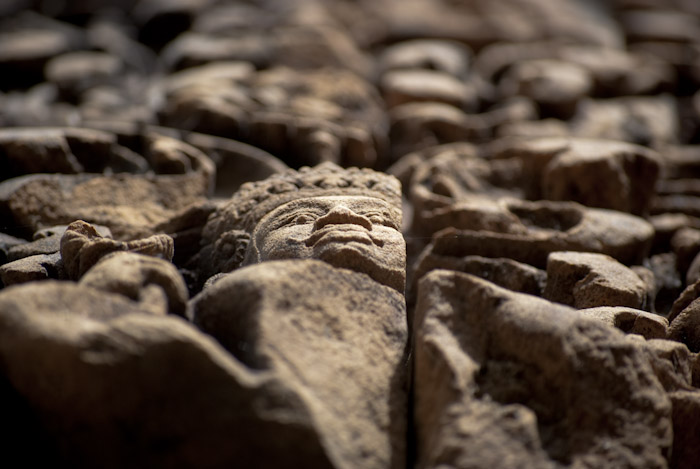
Evening and Bicycle Repairs
We head back to Siem Reap. Although there is some of the day left, we are fairly temple-saturated, and we are also planning to see if we can find a shop to clean Micah's rear derailleur, which is still sounding a bit gritty.
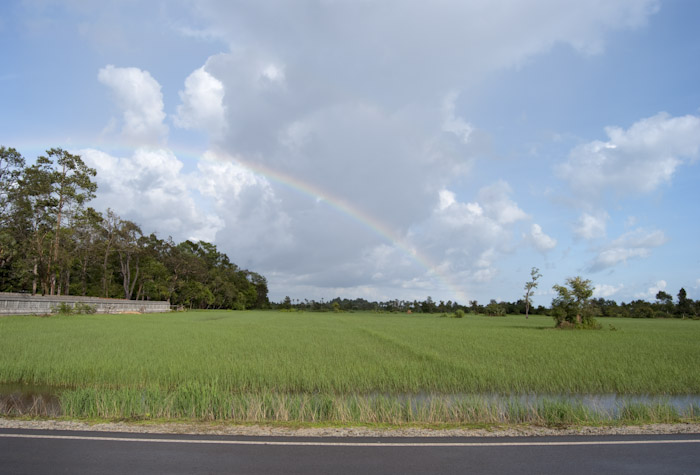
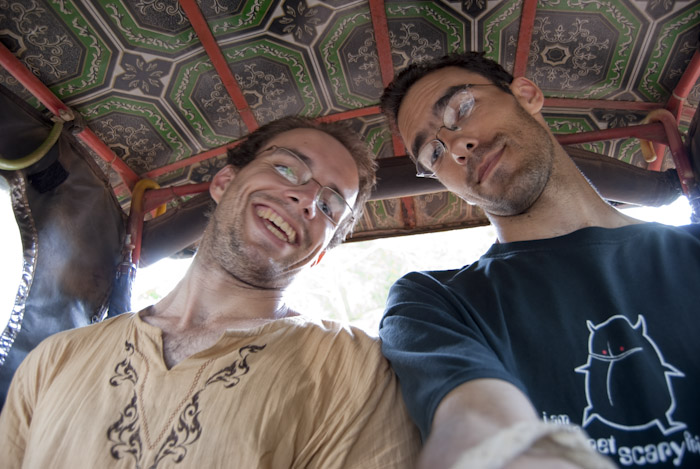
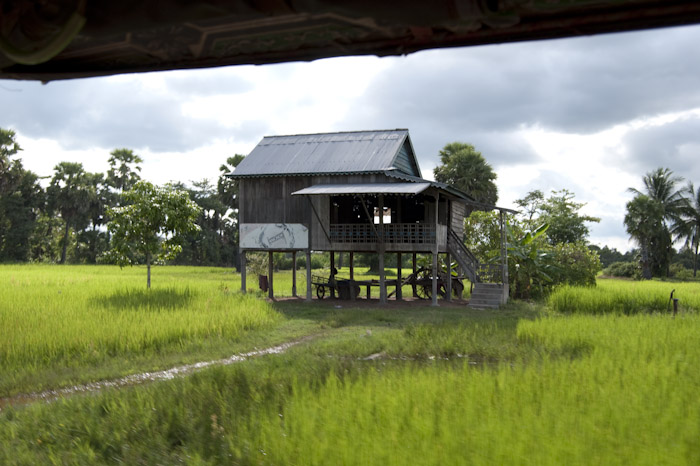
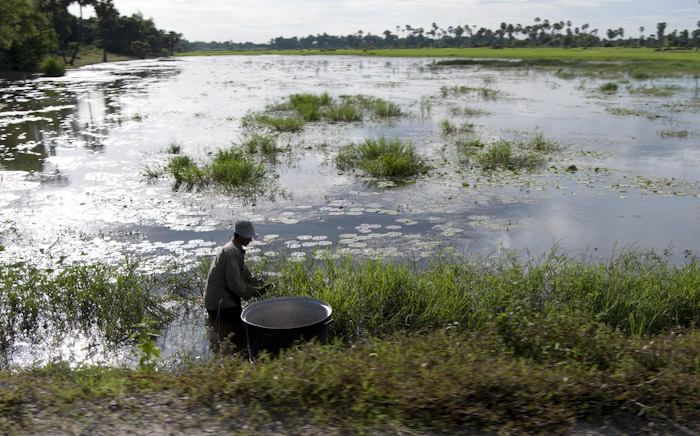
Once we're back in Siem Reap we stop by a few of the many bike shops, but although Micah is able to communicate our concern (pointing, making scratchy creaking sounds and turning his hands), the mechanics agree: it works, no problem.
So, we do it ourselves. After trying to find a container at a gas station store, we find an empty bottle and do our best to dry it out, then buy 1,000៛ of Diesel (as degreaser). (The attendants seem unsurprised to be filling a plastic bottle from a gas station pump.) We set up next to the hotel, dis-assemble Micah's derailleur onto a styrofoam tray, and he rinses the parts in diesel; we then realize that although we have chain lube, we don't have bearing grease for the cage pulleys. I go in search, wrapping one of the gears in a rag and taking it to aid communication.
Saying 'grease' and 'oil' and repeating the squaky-noise-and-motion routine, I am fairly quickly able to communicate some of the problem, but they people at the bike shop where I stop (just up the road) first offer chain lube. I persist, showing them the gear I brought; they look it over, popping out its little bushing, and then bring out bearing grease — a can of thick goop. I check the label, which indeed tells me (in English!) about application to bearings and the like. I ask to buy some, to back with me, but they don't sell cans; instead, one of the men scoops out a generous blob with a finger and sticks it in a spray-can cap. (They refuse any offer of payment.)
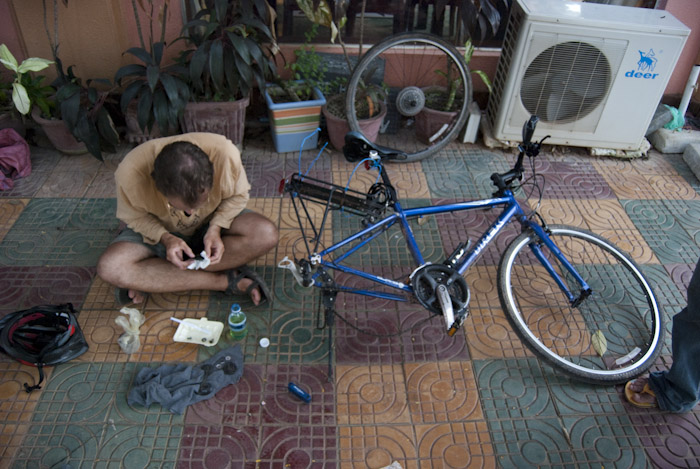
Although it is a little troubling to have half of one of our bikes in pieces at the furthest point of our journey, we do have the option of catching a bus or a pickup back to Thailand. Also, we are confident that in this state one of the bike shops would see that there was something to be fixed.
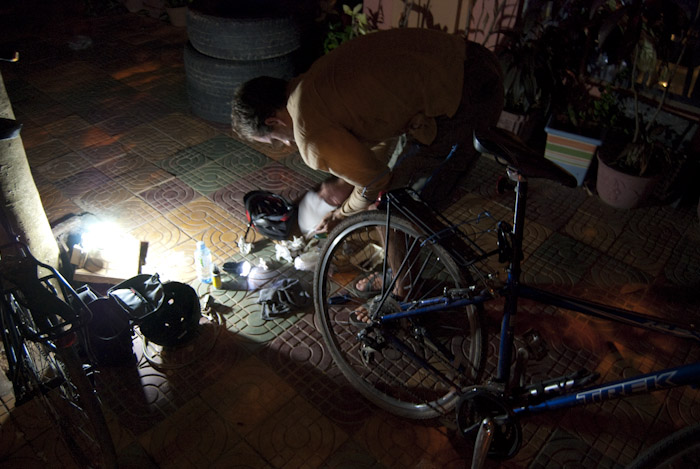
Back by the hotel, Micah re-greases, and we re-assemble. It has gotten dark during the process, and the hotel manager brings us a light to plug in and work by; a few other people have stopped by curiously and been more or less helpful as well. Once everything's back together, Micah takes it for a quick ride: not actualy a lot different, but we're pleased to have had an adventure.
After that, we shower, then try the restaurant attached to the gas station next door. It's Chinese; we have pork fried noodles and milk shakes, all tasty ($7.50). Then, having gotten another fifty dollar bill at one of the ATMs in town earlier, we ask the pump attendants if they can change it; to our pleased surprise they do (after a bit of close inspection), even giving us ideal bills — a stack of ones, two fives and a ten. Back at the hotel, we do some writing, and are in bed around 20:30.
 This work by Mark Fickett is licensed under a Creative Commons Attribution-No Derivative Works 3.0 United States License.
This work by Mark Fickett is licensed under a Creative Commons Attribution-No Derivative Works 3.0 United States License.
